Flying with an IR(R)
Ready for anything the weather can throw at us?
Ready for anything the weather can throw at us?
Post-IR(R) 6 Dec 08
With a Night Rating and now an IR(R) I'm kind of fully-qualified now (many think of the IMC as the second half of a PPL), and with 162 hours under my belt maybe even a little bit experienced. But still hugely capable of doing Really Stupid Things, that I am well aware.
I'm getting very bored with constantly having to prove my currency to an instructor, but there you go: Flight School rules.....
Out to the same aircraft I took my IMC exam in, start up, taxy out, remember the grass run-up area is not in use, take the checks nice and easy, do it all by the book, rotate at 65Kt and climb out trimmed for 75Kt.
It's not until we are nearly at 1,000ft that my Instructor tells me I haven't yet looked out of the window, we're meant to be VFR.
Ah, too much IMC work, you see....
Oh, gosh, it really is rather nice out there, and once we get the heater on and we're above 3,000ft it's beautifully smooth and clear.
HASELL check, 180° clearing turn (Rate One, of course...) and we do a couple of stalls, which are easily dealt with. We do a really fully developed wing drop job, which requires some intense provocation, and amazingly you can really control roll with rudder in this situation. Feels weird, though, and quite ghastly.
We also try a landing configuration stall in a turn, which I've not done before. The solution is more power but you don't need to drop the nose. It feels so horrible, and the onset is so obvious, this is not a situation you really should find yourself in, in real-life.
My clearing turns become more extreme after each exercise, it's so lovely up here I could fly all day. Wheeeeeee!
We head home for an overhead join (now that's something I haven't done in a long while), and are trying to get a PFL from the overhead, so have to orbit at 2,300ft. Crank it round, the runway rotating under the right wing, mental note to try some aeros.
Eventually we give up as the circuit is just too busy and follow a twin in for a flapless touch 'n go. I have never worked out why they teach flapless landings; apart from the nose position, it's just like a normal landing in a PA-28 (in a C172 it's a different matter, of course). All the orbiting has, however, made me forget my downwind checks, which is a potential undercarriage-up landing, so self-slapped wrist, most definitely. A nice, smooth arrival and we're off again for a conventional circuit and flapped approach.
I still find the PAPIs an unwelcome distraction on the approach: they're a bit like the yellow lines you drive over on the approaches to some roundabouts which are meant to help you gauge your braking. If you can't judge your braking you shouldn't be driving, and if you're relying on them what happens when you hit a roundabout that doesn't have them?
I concentrate hard on ignoring them (the PAPIs, not the yellow lines, they don't work well in an aircraft) and use them only as a confirmation that I have the correct approach. On the whole, they tend to agree with me until the last 200 yards, but that's because I like to land shorter than they want. I'm not a business jet and I will land on short runways.
At 800ft on the climb-out the engine dies.
Well, actually, it doesn't, but we need to do a Practice, so it's "trim for 75Kt, pick a field, then if you have time do all the niceties like telling someone, switching the electrics off etc etc". In a real-life engine-failure-on-climb-out situation I know damned well I'd be concentrating on getting the aircraft down in one piece and bugger everything else. I'd worry about that once on the ground.
My chosen field is not ideal but it is within 30° of our course and attainable so we mend the engine and return to the circuit. We will finish with a glide approach.
My Instructor tells me to wait until I am absolutely sure I can make half way down the runway before I close the throttle, but he's still telling me this way beyond the point at which I know I could make it, so I chop the throttle and we're still way too high: it requires 3 stages of flap just to get us down. Our sink rate is pretty high and he's a little discomfited but I'm worried about running out of runway and we touch down gently exactly half way down the runway, which is great.
So no major problems, just a few procedural funnies. Each Instructor does things differently and sometimes pulls you up on things you've been doing for years and no one has ever commented on before. But that's what's nice about using multiple Instructors. A little rust removal never goes amiss, and anyway I love doing circuits (never thought I'd say that).
And now I'm Current once more.
Shobdon 17 Dec 2008
As a result of the messy relationship my previous company had with my aviation my new company has written specifically in its Articles of Association that aviation activity during working hours is not only tolerated but encouraged, provided the weather is good enough.
It's mid-December and the weather is just perfect for flying today. Everyone else is off for Christmas already or having Christmas parties, a PA-28 is available and my friend Clare's daughter Jessie is 20 today so needs a birthday present. Let's go flying....
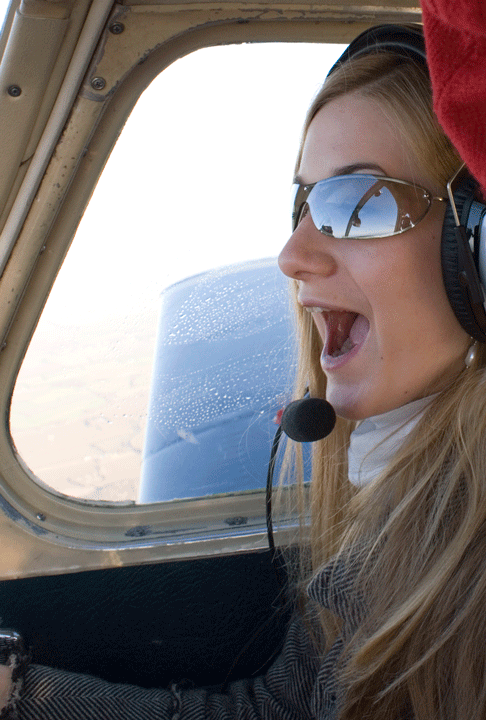
We'll be 4 up in a PA-28-140 with just about full tanks, but I know what everybody weighs. We're at just about MTOW on a long runway, and it's cold. Provided we can get off from Oxford, by the time we make Shobdon we'll be well under.
Water in the fuel first thing in the morning is always a risk and can cause a potentially disastrous loss of engine power on climb-out if not purged from the system prior to flight. It's caused by condensation on the walls of half-empty tanks and failure of the filler-cap seal during rain.
During the pe-flight check I notice no fuel strainer in the cockpit, so although I check the fuel for smell (yup, that's Avgas) and quantity (both tanks just about full) I don't strain and check for water, mentally reminding myself to go back and get a strainer when I get my passengers.
However, as usual we're a bit rushed and the strainer gets left behind. We start up and taxy, then my friend Pete comes alongside with the strainer and passes it through the open cockpit window.
Now I'm in a quandary: do we shut down, strain the tanks, restart and continue, knowing that any water will now be mixed with the fuel by the taxying; or do we continue to taxy but switch immediately to the tank we intend to fly on and thus prove the system on the ground? We've already proven the other tank is OK.
I know it hasn't rained during the night and the tanks are full: in my previous experience this combination has never resulted in any water becoming evident in the drain tube, so we will swap tanks immediately and if the engine so much as coughs during the taxy, power checks or take-off I resolve to abandon or switch tanks.
In practise, the engine does none of the above but with 4 up it takes an age to climb out. Mental note to ensure higher power levels during the approach as it will descend faster.
The weather is perfect and we are sideways on to the sun so no glare issues. The heater is working well, and we're toasty. Once at 3,000ft and with Brize, on the GPS line and some visual cross-checking (that's Enstone, that's Little Rissington) I let Jessie fly it and she's really very good. I can keep a good lookout as there are lots of people up here today.
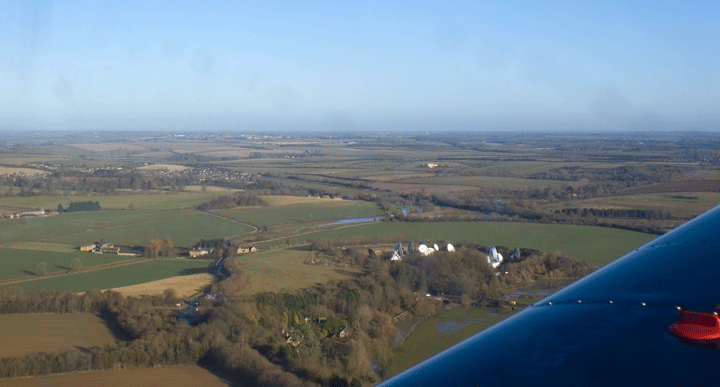
|
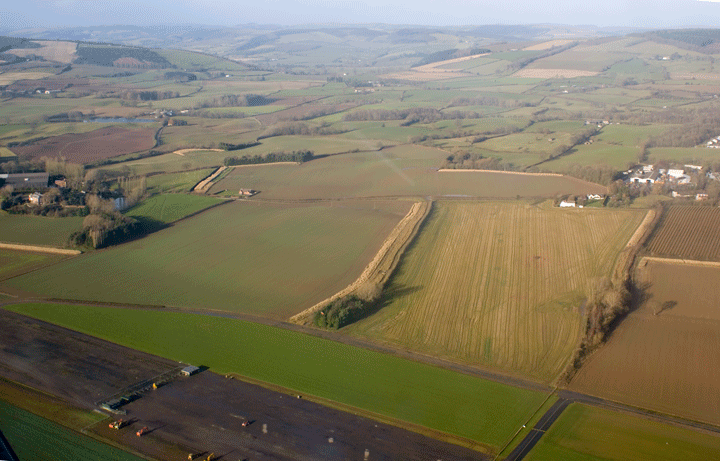
|
|---|---|
We head West over the flooded Severn Valley and once past Malvern switch to the laconic Shobdon A/G (not as bad as Haverfordwest, though!) for a crosswind join.
Just as we turn Downwind, carefully not overflying any of the noise-sensitive areas an Icarus microlight appears heading straight for us. I pass him to the right and then turn back left in to the circuit; he then performs a "microlight" circuit (basically he just cuts the corners) and is then on Final in front of me, the cheeky bugger! So round we go for a full circuit and a few minutes later we're landing (a slightly too firm arrival for my liking) and taxying in on the wet grass for a bacon butty.
But it is not to be: they have just closed the (excellent) canteen for their staff Christmas lunch and butties are "off". We are far from the only butty-less pilots; there is a fair amount of good-natured grumbling from other pilots. The girls (sadly minus my favourite) are good enough to sound embarrassed and sell us coffees and hot chocolates before we head off out again.
Whilst drinking our coffees the most God-awful noise outside announces the arrival of an RAF C-130 Hercules in the circuit apparently after a training Touch 'n Go (On this little strip? Are you kidding?). As they are busy the tower tells him "not today" and he roars away. I can't believe they normally let him land until I see the photo behind the desk of this massive 4-engined military transport touching down on 27 dwarfing everything else on the field. Wow.....
As we leave the clouds heralding the expected weather for the next few days are covering the Western skyline, so we swap tanks, taxy out on the muddy grass (oodles of throttle required to get us unstuck), take off and head East to stay in the sunshine.
What my Instructor told me about doing the IMC has come true: I find I have become very fussy about trimming the aircraft out at exactly 3,000ft, at exactly 95Kts, exactly on the correct course with wind correction, and not drifting up and down the whole time. All my turns are Rate One and I gain or lose no height during them. I have Daventry and Brecon VORs tuned and Idented; I know our bearing from both of them. And this is meant to be just a VFR bimble...
 Once established in the cruise, Clare flies us home; it's interesting watching her make the same mistakes as I used to make: she just can't keep the aircraft straight and level. I've got it trimmed at precisely 3,000ft and that's fine but she's wandering about from left to right like a Learner driver. The more I watch (between scouring the skies for bandits) the more convinced I am that she flies just like I used to when I was learning. It's a wonder my Instructors ever let me loose.....
Once established in the cruise, Clare flies us home; it's interesting watching her make the same mistakes as I used to make: she just can't keep the aircraft straight and level. I've got it trimmed at precisely 3,000ft and that's fine but she's wandering about from left to right like a Learner driver. The more I watch (between scouring the skies for bandits) the more convinced I am that she flies just like I used to when I was learning. It's a wonder my Instructors ever let me loose.....
As we approach Oxford we release ourselves from Brize and chat to Approach who inform us of a PA-32 doing a 100 procedure in front of us. Now I know exactly where that Base turn is, so know where to look, and there he is almost below us, so we tell them we'll do an orbit for spacing over Charlbury and follow him in. Join crosswind and trundle down the approach for a nice-ish arrival, tidy up and taxy in. A nice morning.
And I'll never miss straining the tanks ever again.
Another interesting occurrence tonight: a quick IFR trip to Caernarfon in FS X (using the excellent Flight 1 C172 photo-realistic cockpit add-in) has me performing a picture-perfect NDB departure from EGTK without any real conscious thought: I just "pull the tail" and it all slots in to place. Maybe some of the training has stuck.....
Anti-SAD treatment Dec 08
Christmas Eve dawns dark and gloomy, the sun barely visible under thick overcast. Seasonal Affective Disorder (SAD) has taken over. But Pete has suggested a trip, and an early text finds him as keen as me get some sun.
The airfield is dank and empty, just a C172 pilot kicking his tyres. The cloudbase is low and depressing. With low spirits we untie and start the Mooney, and taxy out. There is so little wind and traffic we can use the main runway in whatever direction we choose.
Maybe we'll get some slightly brighter weather if we can get above the clouds. A second, higher bank is forecast so we're unlikely to see the sun, but we might just see the top of Snowdon peeking through the cloud if we head North West.
At the reported 2,000ft cloudbase we are still VFR and the ground doesn't go murky until we are above 3,000ft. Brize are on holiday so we push on without a RIS.
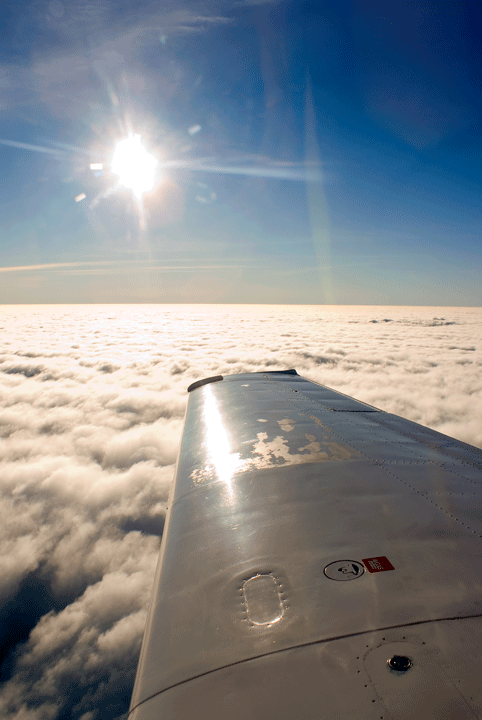
At 5,000ft, like a surfacing submarine, we burst out in to the brightest sunlight. There is no upper bank, just a base of flat cloud as far as the eye can see in all directions. As we rise above the fluffy white layer we can see for 100, or 150 miles. I take it and we climb to 10,000ft where we can see lumps in the base where power station cooling towers are adding to it. And the sun is hot; it's like the South of France up here.
We feel hugely privileged to be up here, where you can't go without an IMC: we talk to London Information and there isn't another plane within 100 miles of us. Today the bright sunlight is only available to airliners and us "VFR on top" folk.
100 miles North West we look for anything resembling the tops of the Snowdonia mountains, but the clouds remain impassive. We will need to turn soon for home: there is nothing to see here...
But wait: that darker section over there. Could that be the edge of the monotonous white plain we are flying above?
As it grows closer, we try to convince ourselves it's not just a shadow, or a different level of cloud. We are well out over the Irish Sea now, and yes! The cloud just stops here: maybe we can slip under and have a look.
Like clearing the edge of the world Pete tips the Mooney up on a wingtip and down we go.
The sunlight goes out like someone hit the switch and we're back in the gloom, but there is enough cloudbase here for us to enter this hidden world.
And there is land under this blanket.
We descend over Anglesey, over the catamarans and ferries of Holyhead, past the slumbering RAF Valley and over the Menai Straits to Caernarfon.
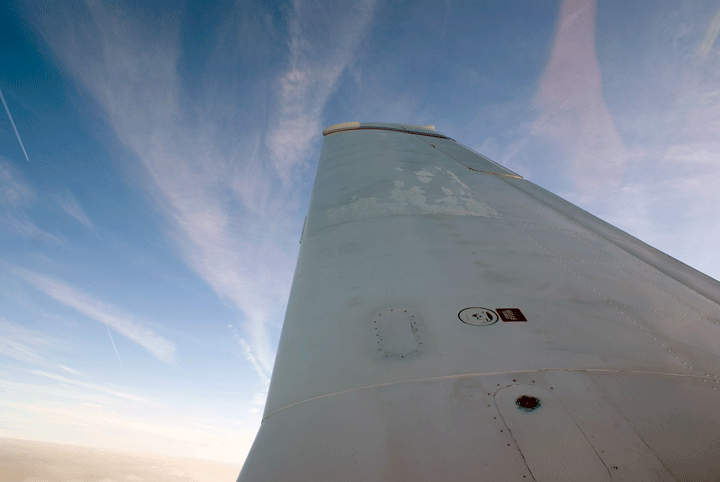
|
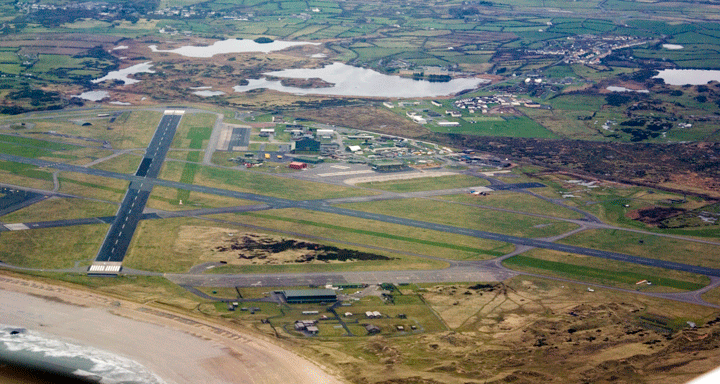
|
|---|---|
We won't stop today (next time!) but continue over the hills and valleys towards Snowdonia. Snowdon has its head in the clouds, but the others are visible and we swoop around them taking pictures. We are truly the only people flying today; the radio is utterly silent.
We fly up the Glaslyn Estuary towards the hydro-electric plant, then Pete turns on a wingtip, we pull some G and reverse down the valley passing Portmeirion for some pictures at 1,000ft and 170Kts. That must have looked good from the ground. Our grins reach from wingtip to wingtip...
A sharp turn back up the valley then Pete grins, opens the throttle and points the nose in the air. Within seconds we disappear in to the clag once more and return to the land of the midwinter sun where I take over and trim out at FL75.
Half way home our GPS spots that we're getting close to an outcrop of controlled airspace, so rather than duck under it we decide to nip round it: any excuse to put the aircraft on a wingtip.
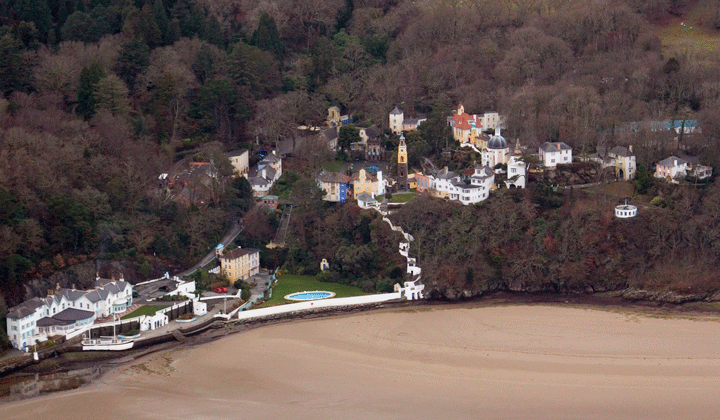
|

|
|---|---|
At 160Kts before we know it we're descending back towards the white carpet 20 miles NW of Oxford. The temptation to flare is strong as we hit the first wisps of cloud, we suddenly get a much stronger impression of just how fast we are going.
As we descend the beautiful sunlight dims and we emerge at 3,000ft in to the half-light of the under-cloud. And it's bumpy down here.
Pete has an interesting trick: our approach is VFR but he uses the descent profile of the ILS to guide his rate of descent but we come in at an angle to the Localiser. This works well, he slows the aircraft down drastically with undercarriage then flaps, lands neatly on 19 and we taxy in, with the big silly grins still all over our faces. These will last for days...
Sideslipping Jan 09
Whilst gardening today I had a brainwave. I have always found it difficult to visualise what sideslipping really means. But whilst pushing a wheelbarrow around I realised that, in a peculiar way, pushing a wheelbarrow is just like flying a plane. Lean to the right, turn to the right, and so on.
But lean to the right whilst applying force to the left, and you go straight on.
And here's the clever bit: it requires more force. So for a given amount of power the wheelbarrow (or aircraft) will slow down (or descend).
Southend in snow Jan 08
It's a beautiful cold wintery Wednesday morning and I'm working at the bottom of a slippery hill in Charlbury.
As I finish up a text appears from Pete suggesting a little wintery fun. How could one possibly refuse?
A frantic hour later Nessa, Pete and myself are lined up on 19. Pete's finally managed to get the right-hand seat all the way down to the floor; it's much more comfortable now my head's not jammed up against the ceiling.
Oxfordshire is bereft of snow but as we head South to Compton the ground grows steadily whiter. By the time we are overhead Reading the snow cover is complete and gets steadily heavier as we head South East.

|

|
|---|---|
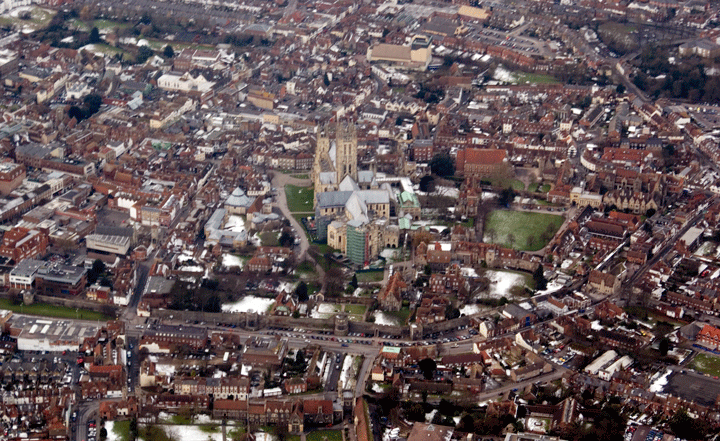
|

|
At 160Kts the country slips past appreciably faster than the leisurely pace of a PA-28 and soon we are South of Gatwick and heading East.
My laughable map-folding is due to a basic lack of planning on the ground; doing my best to simulate IMC for Pete I struggle with the recalcitrant paper. It feels like a Laurel and Hardy movie....
Surrey and Kent are asleep beneath a thick blanket of snow and we spot fields where rabbits and foxes have made the only tracks; fields where cars or ATVs have been doing doughnuts, and fields of virgin white. The world is reduced to black and white.
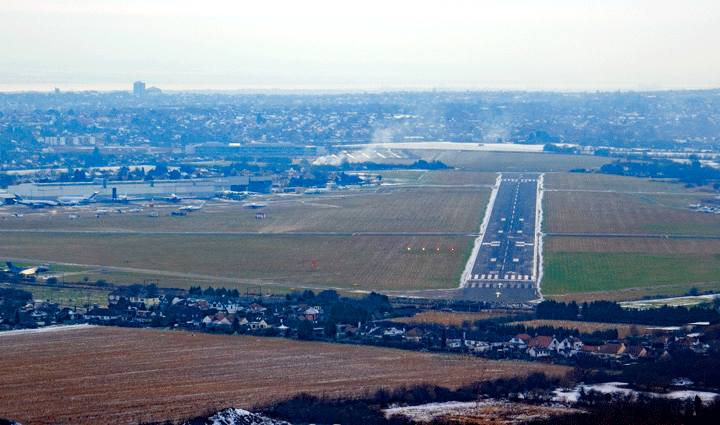
East of the M20 the snow fades until by Canterbury normal service is resumed.
The sky brightens, so we orbit Canterbury Cathedral for pics before heading North West for Southend.
Fifteen miles out we contact Southend Approach who ask us to "wait one" then promptly forget about us until we have to orbit over Southend Pier and remind them of our existence.
The Pier and associated arcades glow in the winter sun, and the camera works better through Pete's clean windows....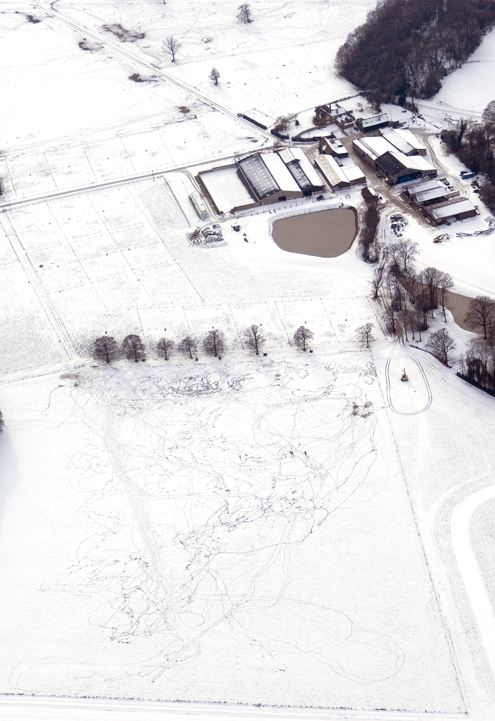
Cleared to join Downwind for 24 we cross the monotonous suburbs of Southend: who would live here by choice?
The area is clear of snow and the ramp noticeably warmer than Oxford. The VIP Lounge awaits and we watch Nigerian internal airways 737s doing engineering run-ups and take-offs over a cup of tea while I catch up with e-mails and phone calls. Wonderful thing, an iPhone....
Landing fees paid, we're back in the plane and off Northbound. It gets steadily snowier as we transit Earls Colne then pass North East of Stansted, watching a 737 descend towards the outer marker.
In the distance we can see Stansted's PAPI's: looks like we're a bit high on the Approach...
We're on the new Stansted Listening squawk and ten minutes later the controller advises us of potentially conflicting traffic (good system, this).
Pete has a pseudo-TCAS system and this confirms the conflicting traffic but not its direction; we eventually pick up a meandering C172 off the starboard side, but he is hard to spot visually.
Surprisingly quickly Aylesbury appears off to our left and we are letting down for a left Base for 19, but as we roll for Final the Tower makes us go round to allow some IMC traffic priority; fair enough I suppose, but it would have been easier for us to orbit for spacing earlier.
Cleared for an early turn Kidlington wheels beneath us, then we're turning Final (a little late, we drift an interesting amount Westwards) and Pete flares for a neat landing.
What a lovely afternoon; beats being in an office....
Rust Removal 15 Mar 09
Working on the house has taken up huge amounts of time over the last three months, and before we know it March is here.
It's scary how time passes: before you know it three months have passed since your last logbook entry, and you need a refresher. This is where a lot of PPLs give up.
Actually I really like going out with a new Instructor: Rust Removal can be fun, because there is always something new to learn.
It's perfect weather; we depart North West requesting the freshly-minted ATSOCAS "Basic Service" (a Flight Information Service in disguise) and climb (slowly, he's a big bloke like me, and this is only a PA-28-140) to 3,000ft, do HASELL checks then some extended stalling.
Now I haven't done this before: usually we are taught the moment it stalls to push on the yoke and get the hell out of there; but he suggests we explore the stall boundary in some detail. It emerges that the aircraft actually stalls a long time after the stall warner lights and at a hugely lower speed than we ever fly (so no surprises there) but that there is a period of light buffet followed by heavy buffet. We experiment with light and heavy buffet for quite some time (and lose a very great deal of height) but I come away feeling a lot more familiar with the deeper stall characteristics, and a lot less worried about them, as they are so easy to recover from. A little like learning to skid a car, when it happens for real you just recover and move on rather than panic.
Then we do some PFLs which go well, apart from me managing to pass quite low over some very swanky country mansion. Still, the engine was idling, and we were above 500ft (just)...
It's really very smooth today, but a bit hazy so landing light goes on, and we do some steep turns over Cornbury Park (well, why not?) then head back for a crosswind join. It's interesting that despite being officially "non-current" none of this is hard, why was it once so difficult?
Managing for some weird reason to be high all the way down the approach I force myself to relax and try for a real greaser as it's so calm. For once, it works, we barely feel the wheels touch; post landing checks and we're home. As I've got a bit more time now, being more on top the building project, the plan (as always) is to fly more.
A timely reminder that Things Go Wrong 30 Mar 09
Monday afternoon:
No decisions necessary on the hiouse CHECK
No poressing work engagements CHECK
Weather OK CHECK
Plane available CHECK
Time to go flying.
I haven't been out on my own for ages, so today I will bimble about without having to impress anyone. It's just me, the DSLR and a mission to photograph the house construction.
It's very quiet at the airfield; maybe the Recession is biting? Check NOTAMs, Book out, start up and depart South. The only other aircraft is a club PA-28-180 departing for Elstree.
It's overcast but the cloudbase is 4,000ft or more, so we'll stay VFR today.
Abingdon is not Active so no need to call 122.1; chop the throttle and descend, camera at the ready. By gum, that house looks big.
Several low passes and startled roofers later I depart to try and find a local strip I've heard rumours of. And it's there, not easily distinguishable from neighbouring fields, but there nonetheless. If I ever do buy anything with wings, that's where I'll put it; within cycling distance of home.
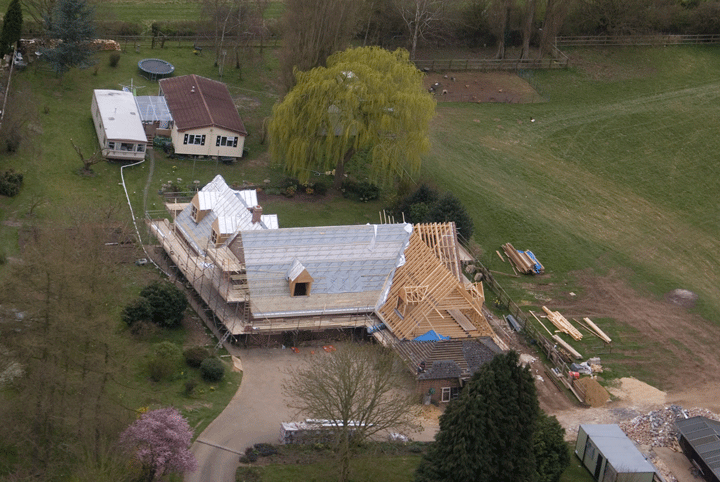
Climb back up to 4,000ft and bimble gently back to Oxford via the very corner of the Brize Zone to see if I can photograph Pete's house. He's very well-protected by trees, so even though I know where he is all I get is forest in the viewfinder.
Whilst I've been aloft the PA-28-180 has returned with a stuck (fortunately open) throttle and is now preparing for a glide approach as the engine is either on full throttle, or off.
The fire engine is in attendance as he does a picture perfect glide approach to a full-stop half way down 19, neatly blocking it. Myself and a Bonanza go around; no big deal but half way downwind he's still there surrounded by vehicles, so request and am granted 21 grass.
I like landing on grass, it's different and feels more rustic and '30s. Line up, drop down the approach and arrive pretty much where I hoped, gently. Tidy up, slow up and arrive right bang next door to the parking slot, so taxy in from there, shut down and open the door.
The PA-28 arrives at exactly that moment, pushed by the fire crew, so I wait for the pilot who turns out to have less hours than me. He has done a very professional job of getting himself out of what could have been a very dangerous situation.
It's a timely reminder that things break on aircraft, and it's much more serious up there than it is down here when they do so.
Hinton: Short-field in the Cherokee Six 2 Apr 09
Preparatory to a planned Le Touquet trip I need currency on the Cherokee Six, so we depart on a warm, hazy afternoon. Whilst the visibility at ground level is good, the slant visibility is bad, so this is good experience.
The Cherokee Six smells and feels different: more like a high-powered 1970s sedan. For those of us old enough to remember, try a Triumph 2.5PI. It has a lovely great 260hp engine and a VP prop, so the whole experience is much less frenetic than in smaller aircraft. Initially it feels more ponderous, but once you appreciate the big motor you realise it's a hugely capable aircraft.
We are to drop Wayne off at Hinton, which with a seemingly very short runway I have long considered to be out-of-bounds to such a big aircraft. But far from it, today we will explore its extraordinary short-field performance.
Once we have found it in the haze, we join Left Base and approach at 80Kts with full flap, dropping to 75Kts over the hedge, land as close as I can get it to the start of the runway and..... bugger me if we don't stop half way down the runway.
Backtrack, eject Wayne and return to the very start of the runway. Call "rolling 06" and roll. Rotate at 65Kts and we're away, miles before I even worry about the far hedge. Ah yes, explains my Instructor, next time try with 2 stages of flap and it'll be even better...
I have many times been on approaches where a quicker descent would have been useful. Flaps are great but once you have deployed them you can't really put them away easily. Spoilers on gliders are better, but most small GA aircraft don't have them.
However, once upon a time, before they invented flaps, the only way of descending was using sideslip, or crossing the controls, or basically turning the aircraft sideways on to the airflow using rudder and adding in cross aileron to keep straight. Not entirely unlike the schuss method of controlling speed on skis.
So we try this at height, progressively feeding in more and more rudder and opposite aileron to get the feel of it. With no external references it feels surprisingly normal, so we try it closer to the ground by lining up on some villages, and this is where it gets to feel weird, a bit like flying sideways. We do get some good descent rates out of it, but it's not until we try it with full flap as well that the VSI goes nearly off the clock, our ears pop and the ground rushes up. Whoa there, Tex!
A few goes at that and I'm getting the hang of it. This will be useful.
We try a second Hinton approach with full flap, better speed control and actually landing it somewhere nearer the start of the runway, and it stops even shorter, so it wasn't a fluke the first time. I shall henceforth worry less about over-running the runway.
We backtrack and this time try the short-field take-off settings: 2 stages of flap. At 55Kts a third of the way down the runway I rotate and it leaps off the ground. Nose down, mind the hedge, accelerate to 65Kts and we're away. Bloody hell, that was quick.
A hazy return to Oxford, join Downwind, 100Kts with 1 stage of flap works best, and we're down the approach and neatly in. And current.
The limitations of an NPPL 3 Apr 09
My friend John has passed his NPPL and I have promised him a trip, just the two of us, which both of us have looked forward to for quite some time.
The low cloud persists until 11am, then suddenly clears like a veil, so we're off to Caernarfon. The deal is that I'll do the landings and take-offs and he'll handle the majority of the in-between bits.
Got to do everything by the book, he's a pilot and will notice the difference... Book out, fuel up with the hairy fuel key, and wend our way. Caernarfon tell us it's clearing, but as we head North West at FL45 the scattered tufts below us turn into solid undercast with the tops at 2,500ft, so despite being happily VFR on top, albeit with no horizon, we are aware that despite the possibility of an IMC let-down over the sea, the weather is going to be miserable at Caernarfon.
Interestingly, John struggles to keep the aircraft horizontal and on course without a visible horizon. I too once struggled with this, it's not just a lack of hours but I suspect a lack of instrument awareness, the only cure being an IMC course. Thinking about it, this is my first "real" IMC flying as P1. Cor, good fun.....
So I make my first IMC P1 Executive decision: we won't go to Caernarfon, we'll lunch at Shobdon.
We divert towards Shobdon and soon find a convenient little VFR drop-down hole, but the cloudbase turns out to be 300ft or so, confirmed by a helicopter pilot on the Shobdon frequency, so we zoom-climb straight back out again: we'll go to Wellesbourne instead.

I haven't been there since my first oh-so scary solo land-away; I hope I can make a better job of it now.
As we track Eastwards the weather improves and by the time we make Wellesbourne we're in bright blue skies. Join Downwind for 18 in a busy circuit, track a nice approach followed by a rather bumpy arrival (oops, sorry John) and park up for a late lunch.
John has a nifty little circuit calculator to help him work out where to fly in unfamiliar circuits, and again it's one of those little crutches that could be useful. A bit like VASIs/PAPIs I prefer not to rely on stuff like that too much, you never know when you suddenly won't have it. But each to their own; if it helps, use it.
Over a Full English heart attack on a plate we chew the fat over good airfields to visit and the limitations of the NPPL. I for one am not convinced that an inability to fly VFR on top or to fly at night adds to anyone's flight safety, plus it does severely limit your flying opportunities, but it's a lot better than no licence at all.....
John seems surprised by the audacity of some of my flights; I am in turn acutely aware of my own lack of experience in terms of "Big Flights": foreign over-nighters, serious gusty crosswind landings, weekends away, incipient spins, flying in complex controlled airspace and IFR Procedures for real. But this will come with time; let's stretch the envelope slowly and build real-world experience. In other words, scare myself witless only once every few flights.....
The return to Oxford is less hazy and we ask for a straight in approach, but get a Right Base join. Ah, not done one of these before for 19. Shake the mental Etch-a-Sketch: I need to be here, at this height, downwind checks here, turn here, and.... ooh, that was fun, here we are in the Approach cone again. Nice smooth arrival (see, I can do it) a bit left of the centre-line (tut tut) and we're home.
Caernarfon in the Cherokee Six 4 Apr 09
The Cherokee Six family Le Touquet trip is cancelled due to the bad overnight weather still sitting over Shoreham: we'll go to Caernarfon instead.
There does seem to be more wind noise than normal but the comms box on this aircraft is a bit funny with more than two people on board, so we continue. It is not until 30 minutes in to the flight we realise the top latch on the passenger door is not latched and, worse, we can't lock it closed in flight. It's not a major issue: the door is firmly closed, but a stream of cold air is whistling around the cabin. We could return but that would add an hour to our flight; we could divert but that would probably add an hour and a landing fee..... We decide to press on, although it's a bit cold at 140Kts and FL50 [much later I discover that the POH states the aircraft may be officially flown not only with the top latch undone but with the door removed for photographic work.....]
Today we know Caernarfon is CAVOK but as we head North West towards Snowdonia the clouds close up again. We can either go over the top and see nothing, or see if there's enough room to safely pass between the cloudbase and the hills. There is, but it's a bit tight in places; we have to twist and turn around the cloudbase and hilltops. I am very careful to maintain good VFR and adequate ground clearance at all times. A little voice in the back of my head replays assorted AAIB reports: "the pilot elected to scud run in worsening conditions", and so on.....
But it's not actually that bad, and it's extremely comforting to know that the "climb in to the murk and attain VFR on top" option is there. The scenery is stunning down here and as we top the last ridge (mind the TV mast) and run down towards the airfield the clouds break.
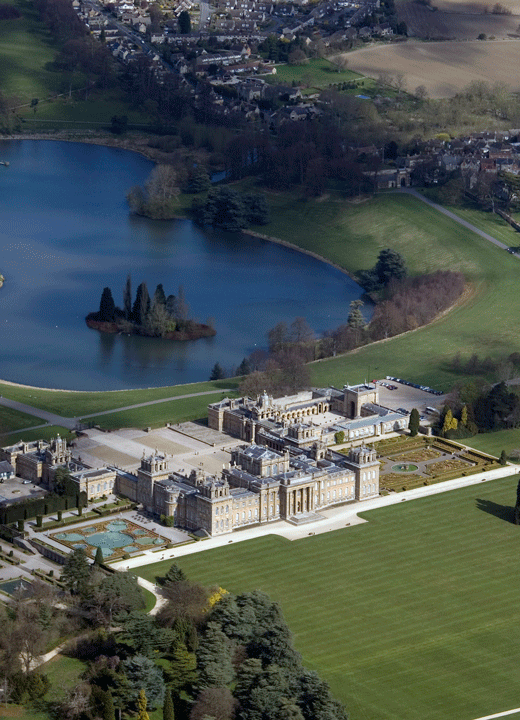
|
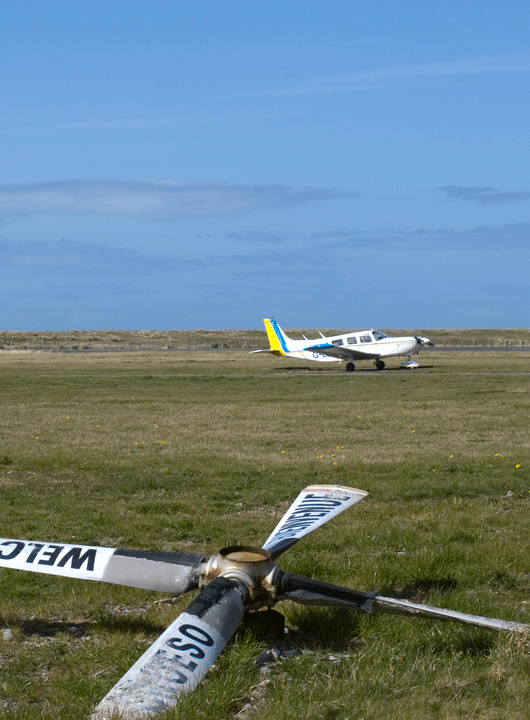
|
|---|---|
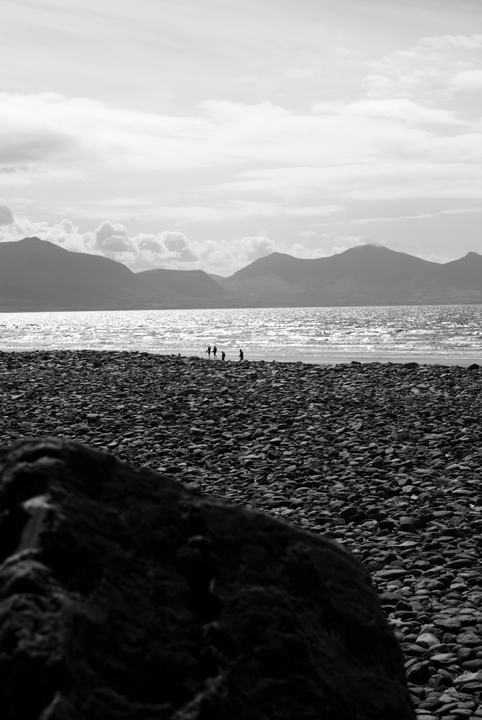
|
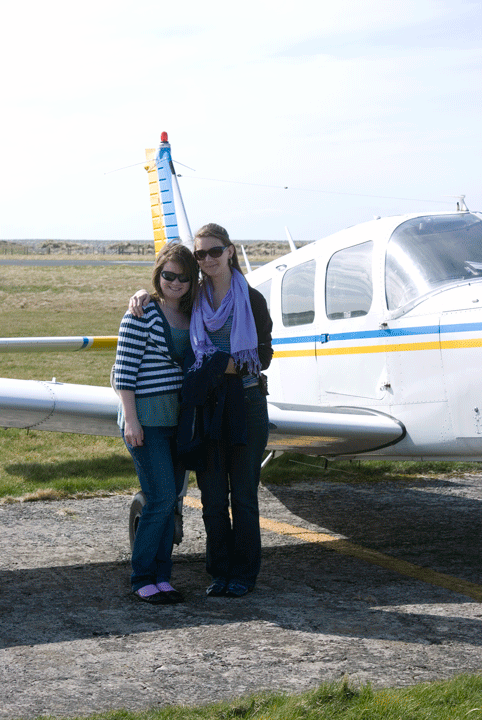
|
Joining Downwind for 26 under blue skies, the short Final is extremely close to the caravan park: I reckon those last two caravans belong to keen pilots and are very cheap.
Nice short landing again, roll out, vacate and park up for lunch and a long walk down the almost deserted beach. Just rewards for a busy morning.All quiet in the back
With all doors securely fastened, stomachs full of lunch and lungs full of sea air we depart over our own message scratched in the sand, perform a gentle right turn and run down the Straits at 1,000ft to Caernarfon Castle and the Menai Straits bridges. Washed by last night's rain, the atmosphere is crystal clear and the fields fabulously green.
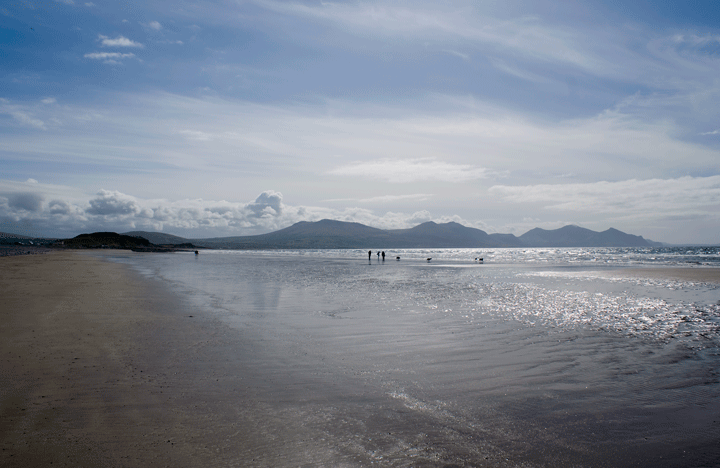
|
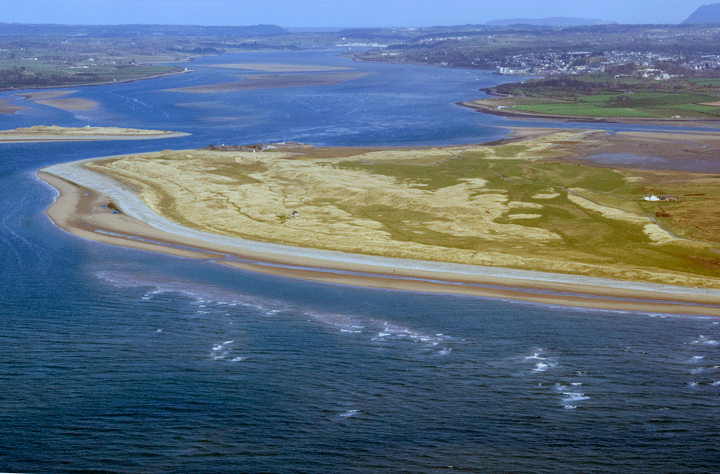
|
|---|
We explore some local valleys before popping over the top to visit Portmeirion, then climbing back up the valley for more sight-seeing. The cloudbase has lifted and we don't have any cold draughts, so it's all lower-stress.
The climb ability of the Six is awesome, so I am never in any doubt about its ability to out-climb the terrain and before long we are over the highest section and bumbling homewards. Soon the girls are asleep in the back and we are admiring the view rolling past us. We can see all the way North to Birmingham and South to Cheltenham. England in springtime is very beautiful.
London Information ask us to report overhead Welshpool (presumably to ensure we haven't scud run in to anything high) then when we are approaching Oxford they ignore four release requests until I'm beginning to suspect our radios. Eventually they respond: evidently the problem was at their end, but by this time we're so close to home I've had to orbit. Plan B would have been to change to Oxford and ask them to tell London Information we had changed frequency, not crashed.
Slow down the savage beast and join downwind for 19. The ATIS gives 290 15 gusting 20Kts and people are using 29 to land on, but by the time we roll Final it's dropped to 290 10Kts and we barely even notice it, except that we drift two feet to the left of the centreline on the flare. Damn it, gotta nail that centreline.
But was the Snowdonia flying dangerous? It was certainly envelope-stretching: we did fly close to the clouds, at some points we were below the hilltops, but there were always plenty of options including the terrain warning on the GPS. The Six has an awesome climb rate and we were by no means fully-loaded. London Information knew where we were and I have a current IMC. So on balance it was fun rather than really dangerous, but certainly not something I would have done without an IMC or in a less capable aircraft.

|
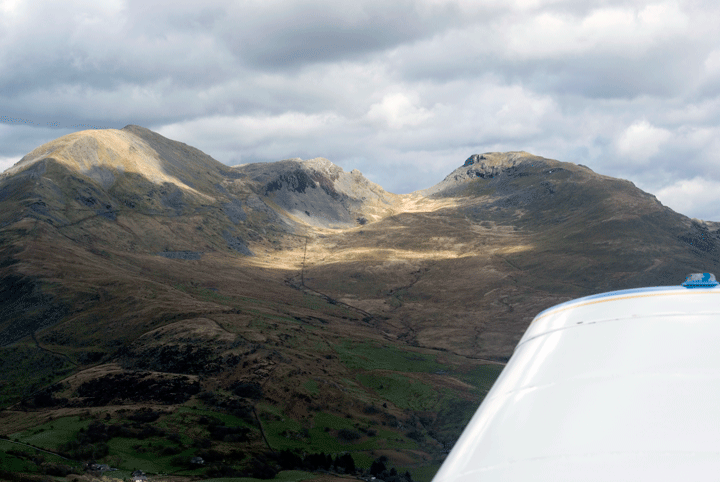
|
|---|---|
It turns out that whilst I was worried about Controlled Flight Into Terrain (CFIT) poor Nessa was terrified the passenger door would come open and she would be sucked out, something I didn’t realise at the time.
She is not good with heights and the sight of the outside world at FL50 through the door frame wasn’t conducive to her enjoyment of the flight. The fact that I knew it was safe, if breezy, was irrelevant: we should have turned back or diverted.
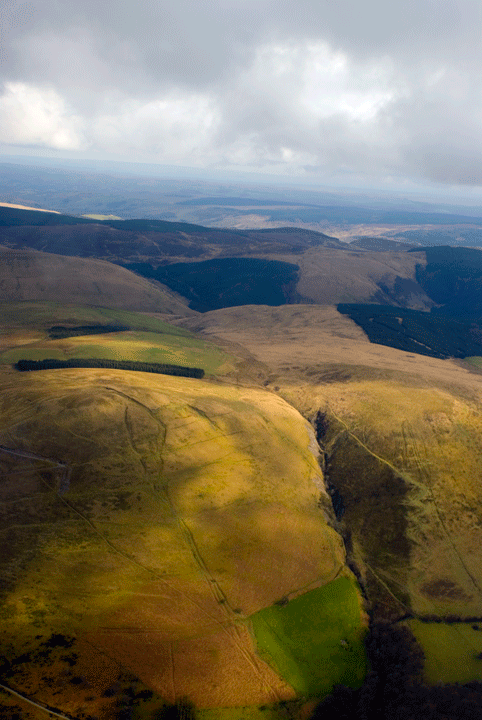 As it would have been a precautionary diversion we wouldn’t have had to pay a landing fee or even get out: we could have stopped on the runway, shut the top of the door, backtracked and departed.
As it would have been a precautionary diversion we wouldn’t have had to pay a landing fee or even get out: we could have stopped on the runway, shut the top of the door, backtracked and departed.
But my desire not to return to secure the door properly and “just get there” was evidence of poor airmanship: the passengers’ needs must come first.
South Wales in the haze Apr 09
Summer is upon us, or so it seems. I'm working on my laptop in the garden when Pete calls and asks if I'm working hard? Well, the answer is obvious: on nothing that can't wait!
Within an hour the recalcitrant server is sorted out and we are in the Mooney on the most glorious mid-April afternoon and headed for Swansea.
We cruise at FL60 over thickening Gloucestershire haze before descending (Pete trying to keep the speed below 190Kts) to sightsee over the Severn Bridges and then shuffle under the Cardiff CTA over the alternately rural and heathland South Wales valleys. For once in this area the weather is great, the haze lessening as we head further West.
At 3,000ft it is amazing how often we see birds at the same height: what can they possibly find interesting up here that could be worth the effort?
Coasting out between Port Talbot and Swansea we line up for a straight in approach for Swansea's 28. The approach is weird: the ground is high so you feel very low, there is a road right on the threshold and the runway slopes down then up. Quite hard to judge the flare accurately, even Pete gets it a bit wrong and we Bruce-land with a bit of a thump but very short: about 300m.
Swansea is a typical GA airfield in many ways: immaculately maintained runways and apron, efficient looking fire services and superb, friendly ATC in clapped-out 1940s RAF-vintage buildings. The control tower is a Portakabin dropped on top of the canteen building and looks a little precarious, but it's got all the right kit and they're very efficient.
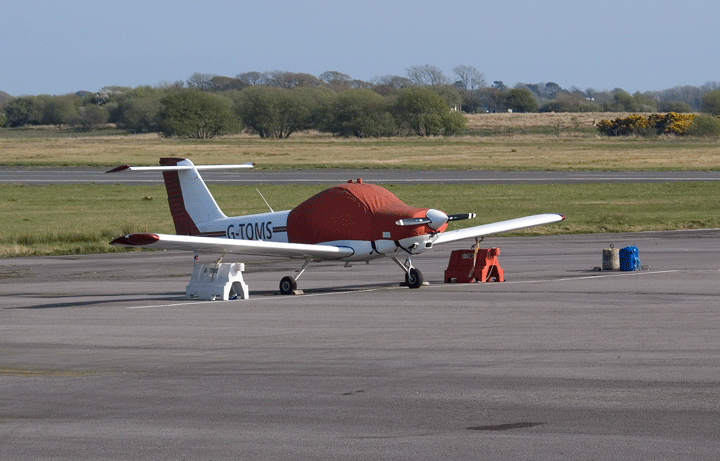
|
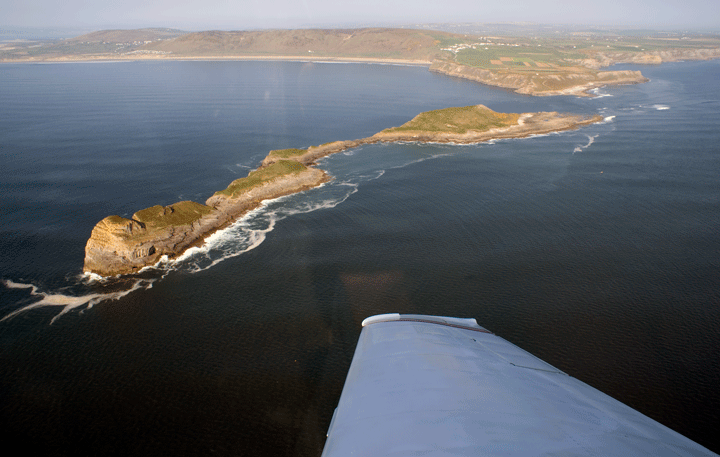
|
|---|---|

|
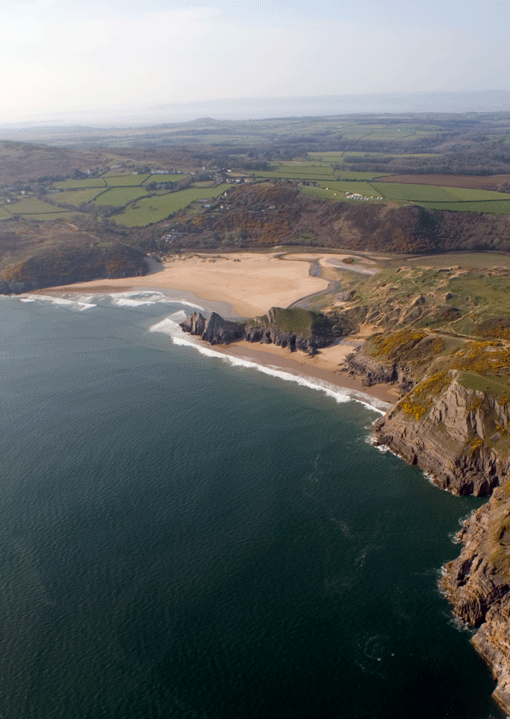
|
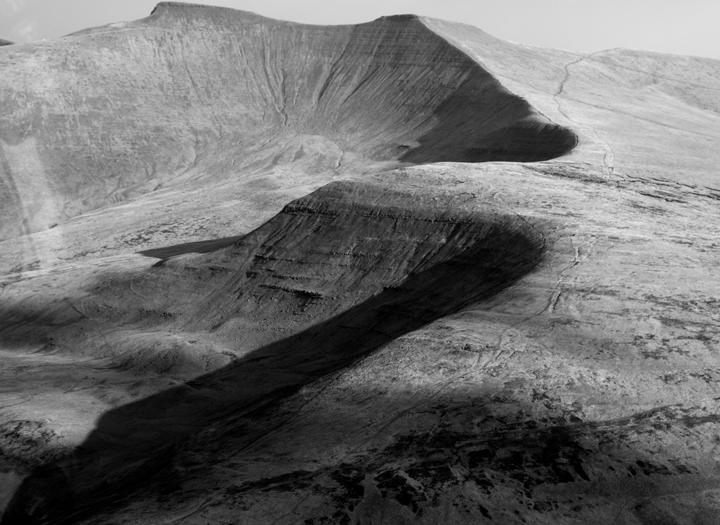
|
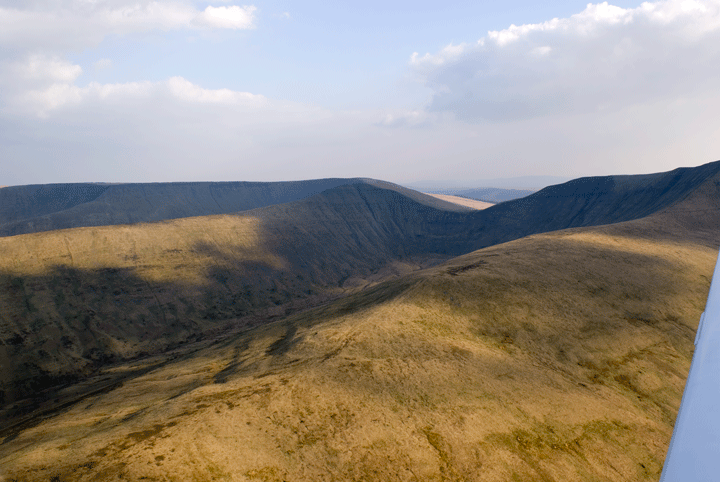
|
After a cup of tea from the nice Rastafarian in the canteen and a pit-stop we backtrack and depart. A low turn and we're out over the rocky coastline of the Gower Peninsula, which is stunning. Seemingly deserted at this time of year and only spoiled by the caravan farms, the lowering sun picks out The Worms Head and Rhossili Beach. When the sun shines Britain is beautiful; it's just a pity it shines so rarely.
After a run around the Gower coastline we head North and pass around the North side of the Brecon Beacons. The scenery up here is massive and the area underpopulated. We fly low over the huge ridges, being bumped about by the thermals before intersecting the Heads of the Valleys road and running down towards Abergavenny.

|
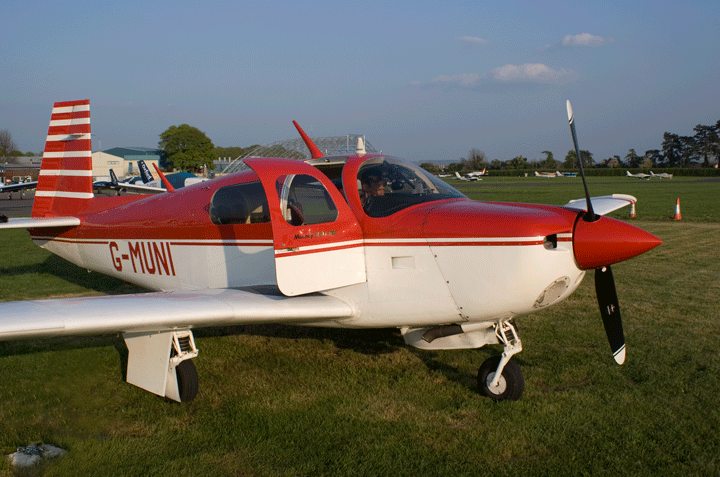
|
|---|
A straight run from there takes us back South of Gloucester where we dodge the gliders. Bristol Filton and Brize have both gone home, so we swap straight to Oxford and a left base join for 01.
If only every day was like this.
Bembridge 4 May 09
It's Bank Holiday Monday, and time to take up a friend who has been asking for ages.
I've been thinking a lot about what to say to people who have never flown in a light plane before: things like "I apologise in advance for my crappy landings" and "the last time I landed here I nearly overshot the runway", although usually true, just scare them. So I'll try to keep it simple and sound professional.
Anna sails a lot, so is used to the "leaning over to turn" bit, and wants to see the Isle of Wight from a different angle (as opposed to through driving rain and gallons of spray, looking up at The Needles, which apparently look a lot bigger when you’ve strayed too close to them in a howling gale...).
I explain about the noise and the lack of a loo, what happens if the engine stops and why I have to talk on the radio so much, and we take it from there.

We do a bit of low-level sightseeing around Oxford and Abingdon then head South.
I'm determined to maintain my various IMC skills, so we'll turn the GPS to the wall and track Southbound to CPT on the VOR. Ident the beacon, swing the dial round 360° (it centres twice), set the OBS, check the flags and steer. My wind-offset estimate is out: we need nearly 20° of offset to maintain track, but we do so and the VOR neatly flicks from "To" to "From" as we head outbound. Cool.
From overhead Newbury we can see the coast, it's amazing that at 3,000ft you can see so far. The weather is brightening as we switch to Farnborough and wonder why everywhere is so quiet. We can't work out if it is the weather, the Bank Holiday or the recession.
Overhead Petersfield we say goodbye to Farnborough and drop down over a suddenly sun-drenched Havant to buzz the shipping in the Chichester Channel at 1,000ft, aluminium masts and sleek white hulls glistening in the storm light. Very few people seem to be out and those all have spinnakers set.
We avoid Goodwood's ATZ and climb back Westwards for the Solent crossing. Bembridge's circuit is very quiet and we are one of only two incoming aircraft.
I'm not going to risk anything clever here: I nearly overran this runway in a C172 a couple of years ago: the approach to 30 is tricky as the land is high and slopes down to the runway, which slopes up. So we'll position carefully for a Downwind join and do an accurate Base turn, call Right Base.... at which point some joker also calls Right Base and we're both looking around going "huh? Where is he?". Evidently he is behind and elects to orbit, but a worrying moment, especially as I had been explicit with my radio calls as to where I was.
Mind back on the approach, which I do actually make a decent job of, this time......
Catch a gust over the road and then drop back to a neat flare over the threshold. STOP panicking about running out of runway (which I've worked out is what causes me to over-flare), just let it run out of energy all by itself, squeeze those last few feet...... and we're nicely down, 1/3rd of the way down the runway, ready for a dab of the brakes, roll just past the turn-off point so call backtracking, backtrack and potter off down the taxyway to park in Row "A".
That was much better: another landing bogie battered to death.
One lovely pot of real coffee later, we saddle up and backtrack to the starter extension. Take-off is short and sweet, we turn South, divert around Sandown's ATZ and are soon following the Southern coastline of the Isle of Wight at 1,000ft.
We track North West to The Needles for piccies, change to Solent Radar and advise them of our intention to pass under the Control Zone VFR via Stoney Cross. Soon we are over the Beaulieu River and then the heathland of the New Forest, wishing I'd had a pre-flight tinkle.
Stoney Cross is absolutely impossible to spot from the air; why it's a VRP I cannot fathom. Fortunately we have GPS but the Mk1 eyeball doesn't have a Hope in Hell...
Report turning North East and squeeze through the Solent/Boscombe Down gap before Solent release us back to Farnborough and we retune the CPT VOR for our trip home.
Anna can fly it straight but not level, or level but not straight. She is keen to try but can't keep all the octopus legs in the string bag at once... but to be fair the thermals are bumping us about a bit, which doesn't help.
Returning to Oxford the weather deteriorates and the wind is strengthening. We join Downwind and they are quoting surface winds of 280° 10 gusting 17 Knots, which is likely to be on the crosswind limits for the landing. We'll give it a try, but Plan B is to go around and use the grass runway or runway 29 (or, in extremis, Enstone until the wind calms down).
As we turn Base another PA-28 is holding for departure. The tower clears him to take off but he fails to respond to their repeated calls until we are about to turn Final. As landing traffic has priority he is about to conflict with us so the tower cancels his take off clearance. Not only does he fail to respond but he starts to roll forward.
I'm not bothered: I can always go around and get an early turn but the tower is getting very cross with him, and the operator's voice goes up a couple of octaves asking him to "respond". Eventually, however, he does respond and we are cleared to land. It's bumpy and a lot of crab and a bit of wing-down is needed. Aim for the upwind side of the runway, keep a few extra Knots on for the bumps, flare, kick off the crab and drift...... and we're down, a bit of a jerk as we kick straight, but we're rolling and it was all drama-free.
As we exit the aircraft it starts to rain, so we timed it perfectly. I didn't scare my passenger: she enjoyed every minute, and wants to come again. And that's the important thing.
Ask not to Whom the NOTAM refers. It refer to Thee. Kemble 20 May 09
After what seems like weeks of windy rain the wind dies and the clouds lift. It's lunchtime Wednesday, and having overseen wiring of a client's office I spy a clear patch, both in terms of weather and work, so Nessa and I decide on a cup of tea at Kemble.
We are planning a trip to a "not normally for Group A" microlight training field to see some friends next week, and will be taking a PA-28-180 as although I am confident I can get in, I want to make absolutely sure I can get out again 4-up! So some short-field familiarisation practise would not go amiss: We Shall Experiment...
I love the moment when, having done all the planning and preparation, you open the cockpit door and smell that warm, expectant combination of aircraft fuel, oil, de-icer, leather and vinyl that to me is GA.
It's hot in the cockpit as we pre-flight and start-up, avoid the roadworks on the taxyway and take off.
We route Southbound towards Abingdon and remain low so we can orbit over the house and take some pictures of our new roof. It's bumpy down here amongst the thermals.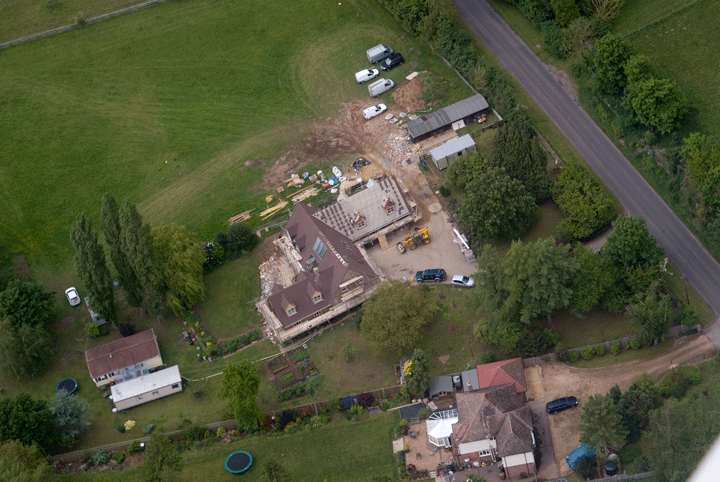
Climbing out we head West and get a Basic Service from Brize who then, somewhat surprisingly, clear us through the Fairford MATZ at 1700ft.
Fairford's ATZ is NOTAM-activated and whilst I did check the NOTAMs prior to departure I managed to miss this Vital Fact. It's not until I get home and re-check that I can confirm the activation.
Oops; that could have been a Problem had I not been talking to Brize.
The Lesson Learned for today is: take checking the NOTAMs seriously: they may well apply to you....
Once clear of the Fairford ATZ and with Kemble spotted we dial-up Kemble for a Join and are asked to Hold outside the ATZ for a Spitfire display routine, which looks impressive from here, certainly.
Once he gets back in to the circuit we position to join Downwind for 26 and call turning Base at the same time as another PA-28: both of us are then desperately searching for each other.... It turns out he is well behind so we have priority and we turn for a gusty Final. As we descend on the Approach the South West wind rips across the trees and shakes us about: there is a fair amount of turbulence here, which is fun for me but disconcerting for poor Ness.
It's interesting flying an approach at 75Kts, everything seems very slow and controlled after the Cherokee Six.
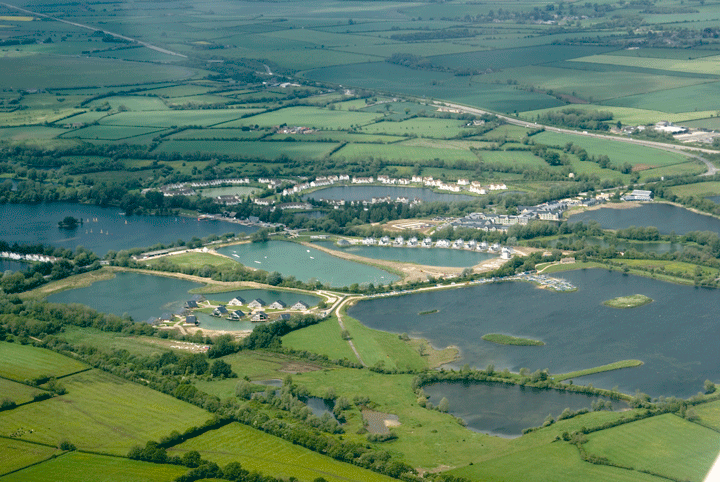
I want to spot land, which seems daft on such a huge runway, but next week I will need to be accurate, so practise is essential. And we almost make my aiming point (which is not the start of the runway, or we would be taxying for half an hour), flare and slightly misjudge the round-out, so we land with a bit of a thump. Must stop doing that.
My favourite bit comes next: we taxy on to the grass and are cleared to park outside the restaurant.
We park up behind a very new-looking Cirrus SR22. Mustn't scrape his paint on the way out....
Whilst we have a cup of tea outside the wonderful (and quiet) AV8 restaurant a dark-skinned rich-looking chap in his twenties emerges with an Instructor and heads for the Cirrus.
I think Daddy's just bought it for him and the Instructor is teaching him how to fly it (lucky bugger!).
It turns out they're from Denham, which fits.
He does have a few problems starting it, though, before following us all the way down to the start of 26 (about 4 miles).
Why didn't they just clear us to the runway midpoint?
Following a motor-glider landing (he has trouble with the wash from the trees as well) we depart North and head for North Leach, swap straight to Oxford and join Right Base for 19. Another practise spot-landing, more successfully this time, and we perform a "no-feel" landing, where the only way you know you're down is the rumble from the tyres. Aaaaaah, bliss.
Taxy home and report the crackly PTT switch, not that I'll need that next at our non-radio destination strip....
Serious Short field Practical Test - Darley Moor 29 May 09
A friend living in Ashbourne has invited us up to visit Alton Towers. That’s a 2½ hour road trip each way, no fun as it’s going to be a hot day.
Hmmm, let’s have a look at the local airfields.....
It turns out there is a local microlight / paragliding field just South of Ashbourne called Darley Moor. Most of the WW2 airfield has been wasted by being converted to a motorbike racing circuit, but one small part has been retained as a North-South 750m grass strip. The owner is friendly and allows Group A aircraft in by prior permission following a briefing. No problem, we brief away and set the date.
My only concerns now are the mechanics of getting in and out of the strip.
My spot landings have slowly been improving, so I think provided I use all the flap, get the aircraft on the back of the drag curve and control the speed I should be able to stop in time.
But getting out again 4-up is going to require some power, so methinks a PA-28-140 won’t do, the Cherokee Six is off on an Annual, so the PA-28-180 it is. The grass is smooth but fairly long, book figures show a roll of 402m but factoring in grass and Public Transport requirements takes it close to 700m... My figures show we can do it with half tanks and one stage of flap, but it’s tight.
Flying from Oxford has few disadvantages but one of them is the long, long runway that doesn’t encourage short-field take-offs or landings. I’ve always (much to the amusement of my Instructors) wanted to land short as I know one day I’ll need to land on something a lot shorter. But I have done very few short-field take-offs. I know the theory: 1 stage of flap, fly her off at 60Kts. But actually doing it is something else.
I’ve asked for tabs tanks but when we turn up early in the beautifully sunny morning it turns out the tanks are full. Whilst I would normally not complain, today this might be a problem. Getting out of Oxford is easy, I can just wait and wait and wait and eventually it will take-off, but the other end will be more difficult. My calculations show we can do it provided we burn off some fuel on the way and do a sightseeing trip 2-up to burn more fuel.
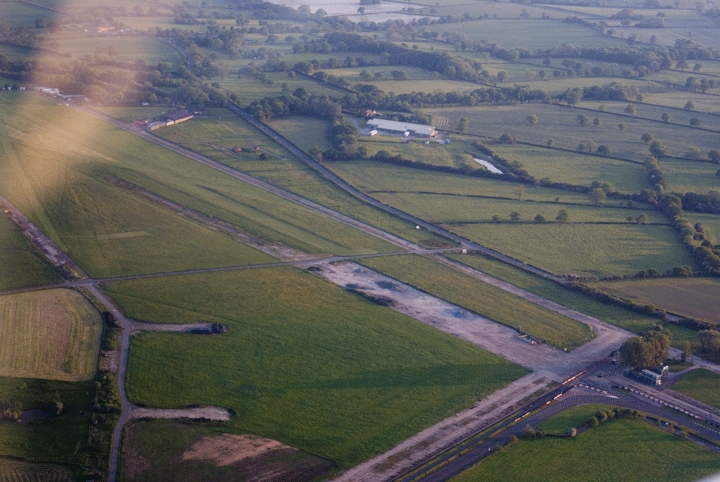 I practise a short-field take-off on Oxford’s runway that seems to stretch to the horizon: 1 stage of flap, stand on the brakes, full chat, release the brakes, a boot of right rudder, speed rising, Ts & Ps good, at 60Kts heave it off and..... the stall warner blares but we’re airborne; nose down and accelerate in ground effect then climb out at 75Kts. OK, so that’s doable, and we hardly used any runway. Bet the tower had a laugh at that one.
I practise a short-field take-off on Oxford’s runway that seems to stretch to the horizon: 1 stage of flap, stand on the brakes, full chat, release the brakes, a boot of right rudder, speed rising, Ts & Ps good, at 60Kts heave it off and..... the stall warner blares but we’re airborne; nose down and accelerate in ground effect then climb out at 75Kts. OK, so that’s doable, and we hardly used any runway. Bet the tower had a laugh at that one.
Weston-On-The-Green is Active so we avoid that and head North towards Banbury and then Rugby. As we approach Rugby I change to East Midlands who tactfully suggest I use Coventry as my route takes me closer to them. Ah, yes, quite right....
Coventry guide us North until we are overhead Nuneaton, then we change back to East Midlands. I’ve never flown North of here so this is already an adventure. Aiming between Tatenhill and Derby we scoot along the underside of the East Midlands TMA until we should be seeing Darley Moor. And there it is right in front of us.
Say goodbye to East Midlands and descend to 1000ft for a fly-past so they know we’re coming, then a Western circuit avoiding various NIMBYs before turning Final. The wind is from the East so I can either land N-S (20) or S-N (02); the choice for Final is between tall trees, or trees with power lines. I am allergic to power lines (especially in this aircraft) so we’ll go for the tall trees option.
Full flap, lots of power, 75Kts, turn Final, aim just above the tall trees, then dump everything as the trees disappear under the nose. With 4 up we drop like a stone. A quick burst of power to clear the fence then flare and the wheels sink in to the soft grass. A surprisingly gentle arrival and we use about a third of the runway to slow to a taxy. Oh, yes, Love This.....
Our friends are waiting and the Reception is friendly. They don't get many Group A aircraft and I feel like a "Heavy" amongst the paragliders and microlites.
After a day at Alton Towers it's 8pm and we're back at the airfield. We start up and prepare to leave. The windsocks are indicating the wind straight across the runway so we have the choice of avoidable tall trees or unavoidable smaller trees with powerlines thrown in.
This is going to be a difficult one: we have no headwind, we are close to MAUW, the strip is 750m of long, quite soft, grass with a 4ft fence at the end. Beyond the fence is grass for several miles but straight ahead is a stand of tall trees I came in over. Getting the aircraft out of the parking space required a LOT of throttle, so I know the ground is soft, hence draggy. We are backed right up against the fence.
The theory goes that provided we have 2/3rds of flying speed (40Kts) by half way down the runway (I know where that point is) we'll be OK, otherwise we stop and think again. The runway is wide so I can take it at a slight angle that will allow us to fly right past the trees on the way out. So much for theory....
1 stage of flap, stand on the brakes, full chat, Ts&Ps good, release brakes, ground speed rising but oh, so slowly.... Watch the ASI like a hawk, half way point and decision time. We just have 40Kts, we'll make it but it will be tight.
My short field experiments have shown that if you heave it off it at 60Kts it will complain but it will bunny hop enough to get it over a fence. Even if we sink back down afterwards into ground effect we can then accelerate from there and it will climb at 65Kts or more.
So at 60Kts and with the fence now extremely close, I rotate and we take off. The stall warner shrieks, but we're over the fence (some careful measurement of the GPS traces in Google Earth later much later shows us 3 feet above the fence) and aimed just past the trees.
Yoke forward, fighting the temptation just to keep pulling, because at this point it won't do any good, we've no reserve lift.
Trade height for speed as we sink back to fence height over the motor racing course, but now we've got 65Kts and a positive rate of climb; the trees flash past 20 feet off the left wing and considerably above us at this point.
At 300ft we finally drop the flaps climb very gingerly away, and breathe again.
Lesson learned: don't overestimate the performance of the aircraft, you will not get away with it.
What could I have done better? Dumped most of the fuel, I think, maybe left a daughter or two behind and picked them up later?
It's a beautiful evening; we turn South and climb, talk to East Midlands and then a bad-tempered Coventry who are berating some poor pilot in a Cessna 152 who seemingly is simply not where he says he is. The Tower gets increasingly cross with him as we pass. I know how he feels......
45 minutes later we join Crosswind for 01RH and touch down, taxying in as the lights go on. We made it.
Compton Abbas Bembridge 4 Jun 09
My friend James has asked to come out for the day, and it's brewing for a perfect flying day, so we'll go out.

Two up in a PA28-140 on a warm, windless June weekday we should meet few aircraft and have our pick of airfields to visit. So we start by taking some aerial photos of Oxford and James's house in Abingdon. It's interesting flying over the town where I grew up and really seeing it from the air - it bears a striking resemblance to the towns you create in The Sims computer game, with immense amounts of green space you can't see from ground level.
From there we head for Compton Abbas, my favourite small airfield on the top of a picturesque hill in Dorset.
James is a sailor and knows something about helming, so it's no surprise that he proves more than capable of keeping the aircraft on a straight and level course despite being bumped about by thermals, as I navigate and communicate our way past Membury, Lyneham, Devizes and Shaftesbury. On the Lyneham Zone frequency it appears we are the only traffic.
Compton Abbas soon appears; as they are using runway 08 today we join overhead and descend in to the weird 800ft circuit. As the airfield is on a hill the apparent circuit height varies hugely depending on where you are, especially on Final as the ground rushes up from the valley. It's a little disturbing, but I am determined to go for a greaser so must concentrate on nailing the approach angle and aiming for wheels on the threshold at 70Kts. Amazingly, we manage another "no feel" landing on the soft grass, roll out on the gently undulating turf and taxy in for lunch.
It's relaxing eating out on the terrace in the sunshine amongst the pilots and spectators: just the right temperature, with a light breeze. A few aircraft come and go but it's generally quiet. Lunch is delicious and filling, and we discuss where to go next. If Simon is in at Shoreham we'll go there, if not we'll go to Bembridge.
Start up, taxy out and take-off Eastbound before climbing South for the coast. We change to Solent Zone who advise we contact Bournemouth as we are closer. Bournemouth turn out to be very busy, handling us and one other light aircraft but mainly a steady stream of EasyJets. James is impressed we're on the same frequency as the big boys, but you can quite understand why the controllers need to see the whole picture to keep everyone apart.
We turn left as we approach the coast and head East over the mouth of Poole Harbour: James is keeping an eye out for boats. We report coasting out and continue to The Needles then along the South coast of the Isle of Wight. It's actually great being flown and being able to take pictures out of the "Direct vision" panel (that's an opening window to most of us).
Around Ventnor we make the decision to take tea at Bembridge, so swap from Bournemouth and fly inland to join the Bembridge circuit. Join crosswind left hand for 12, get the approach right and land neatly if not quite as imperceptibly as at Compton Abbas.
After a cup of tea and a flapjack on the terrace we saddle up once more, taxy out, backtrack 12 and take off over the caravan parks then the sea.
Climbing out, we head North over Portsmouth where we were both at College (at the department of Mechanical Engineering and naval Architecture, no less) and North towards Odiham and Farnborough. Change to Farnborough, get an Odiham MATZ transit and bimble North through the increasing afternoon haze.

|
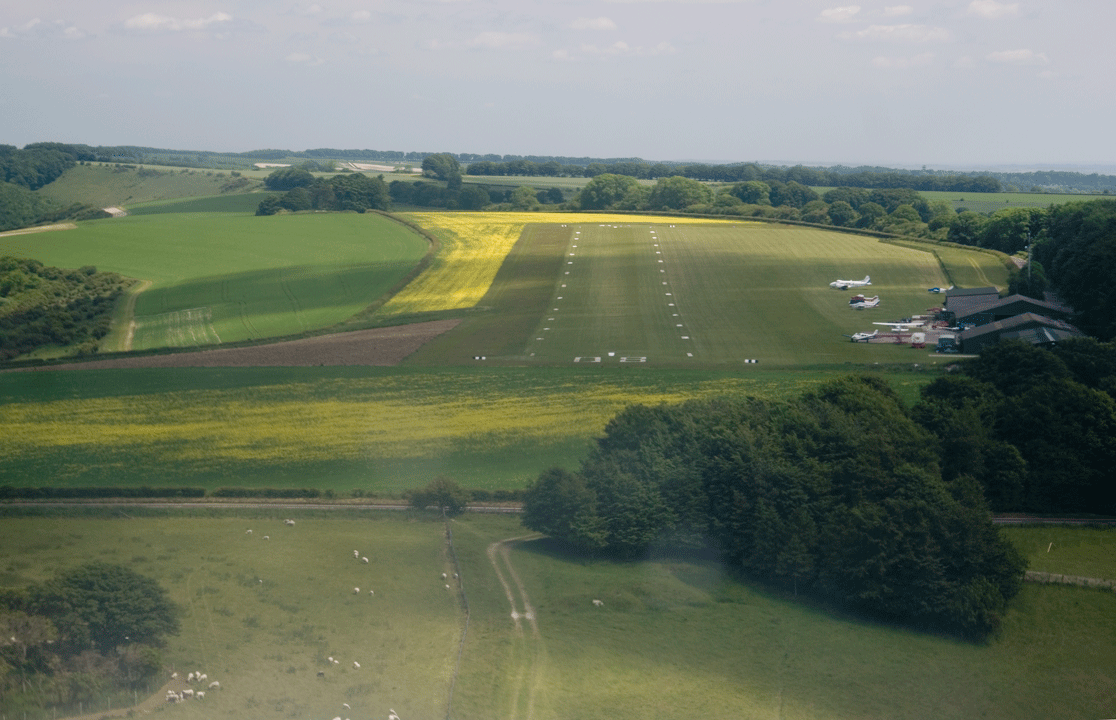
|
|---|---|
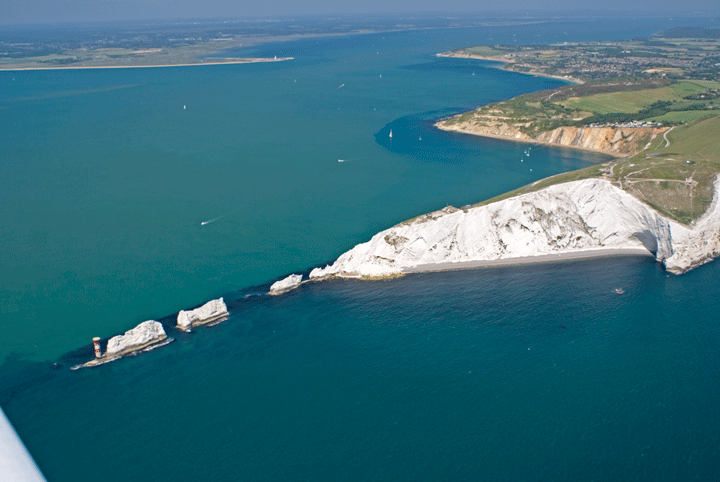
|
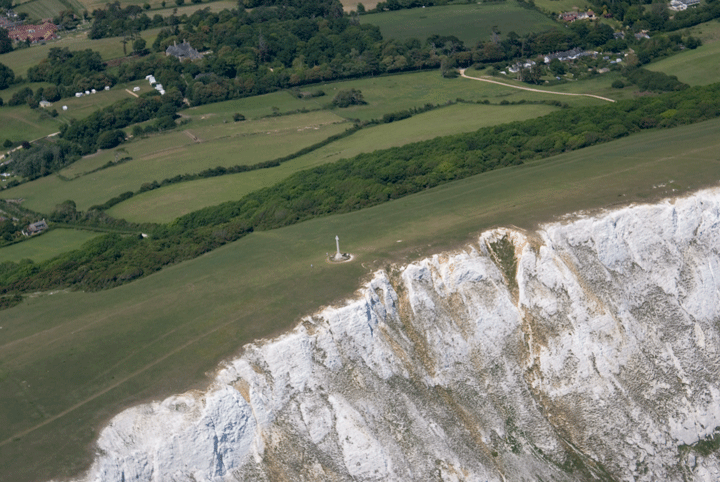
|

|

|

|
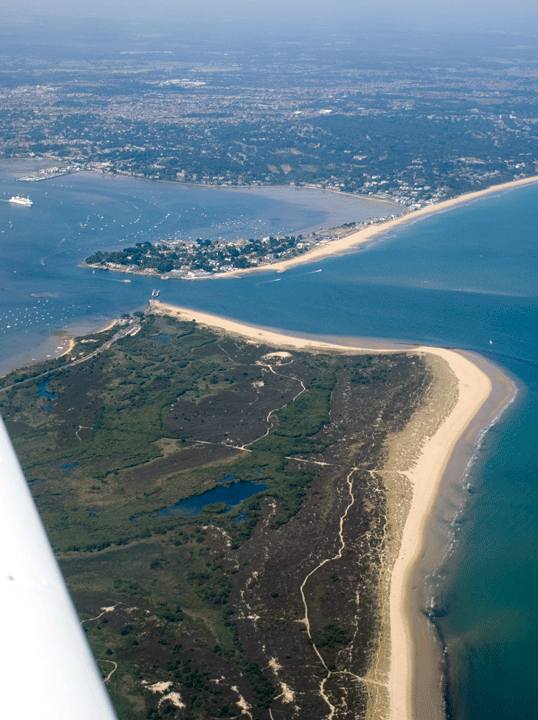
|
Overhead Newbury we change back to Oxford, skirt the Didcot power station cooling tower thermals and descend gently for a right base join for 01 where we are the only traffic in the circuit. Where is everyone?
As we walk in we are both wondering where to fly to next: certainly on a day like today it seems a waste not to be in the air. When the sun shines Britain is a wonderful place to live, and especially to fly over. Such a shame it doesn't shine more often.
Brimpton Jun 09
Stephen has a share in a Cessna 175 he keeps at a strip.
I've often wondered what it's like to fly out of a farm strip, and this sunny evening I have the opportunity to find out.
Brimpton is absolutely in the middle of nowhere and completely unsignposted.
A complex of metal hangars; some open, some closed, are clustered around 520 metres of surprisingly well-mown strip. Maybe ten aircraft, some under covers in the open, and some in the hangars, are in evidence: Cessnas and Robins, a YAK, a SAAB Safir and a PA-38 Tomahawk.
All is quiet, except a glider that lands neatly on the runway. We watched him circling as we drove in and we reckoned he was running out of height.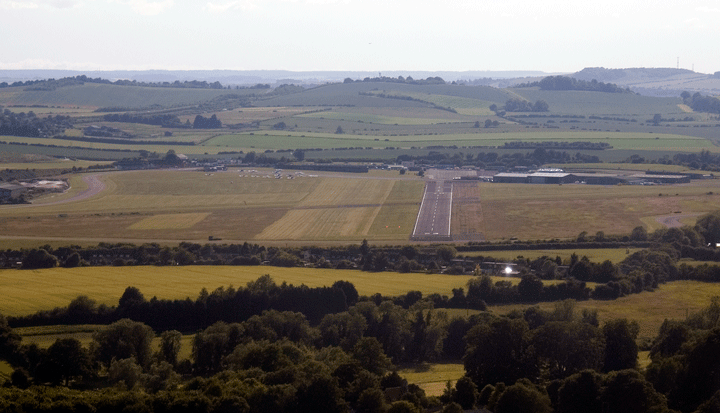
The first thing he asks as we help him clear the runway is "where am I?". Now that worries me.....
Anyway, to business. Being Strippies, not only do we have to unchain and uncover the aircraft, we have to wash the flies off the windscreen as well, with bucket and sponge.
It's very friendly and relaxed, this Strip Life: there is no need to book out. We just start up, quick radio check, taxy to the end of the runway and take off.
Fresh my Darley Moor experience, the runway does look very short from where I'm sitting. Fortunately, this C175 has 180hp and a wobbly prop, so goes like the clappers when you open it up, and we're off well before the end of the runway, climbing to 2,000ft and setting course for Thruxton for some fuel.
The Berkshire countryside is prosperous, green and tranquil. I never tire of seeing the earth from above, and how hills appear flattened by even small amounts of height. Roads wind tortuously around what appear to be tiny hills from up here (they appear larger from a pushibke...).
 Before long we are on Final for Thruxton, where if you overrun the runway you end up in someone's factory, so we land short and taxy up to the pumps. The very nice fireman fills the tanks and we nip off over the track to the Control Tower to pay, then back in to the air and off in search of crop circles.
Before long we are on Final for Thruxton, where if you overrun the runway you end up in someone's factory, so we land short and taxy up to the pumps. The very nice fireman fills the tanks and we nip off over the track to the Control Tower to pay, then back in to the air and off in search of crop circles.
Now I do believe, passionately, in crop circles: they most definitely exist and are most definitely created by silly buggers in the middle of the night....
This particular one has been created in the shape of an octopus; it takes us a few minutes to find it, but then suddenly there it is and we circle over it for piccies. The C175 is a stable photographic platform but, unlike the C172, the side windows don't open!
After a few circles of this and some gentle bimbling around Lambourne we head for home, and Stephen gets the C172 right on the back of the drag curve with full flap, and pops it down on to the bumpy grass. Now I've done some short-field, it doesn't look so scary, and I'm also well aware that it's not getting in that's the problem, but getting out!
I could quite get used to this relaxed way of aviating; there is a strip within cycling distance of my house with hangars and nearly 800m of well-mown grass, so the following Saturday morning I'm down there on the bike talking parking and hangar space... This is most definitely the future.
Stapleford 23 Jun 09
As we've now finally moved in to the house we've sold our static caravan to a couple in Essex, and forgotten to include a couple of small cupboards, plus we managed to leave the poo pump remote in the caravan, and we want it back; so a trip to Essex is necessary to do the swap.
The traffic on the M25 is always awful and they live 5 minutes from Stapleford airfield, so flying the kit over has got to be easier, surely?
I owe Pete a flight as well, so we will be furniture removal men for the day.
It takes an hour to fuel up, fit the four cupboards in the back of a PA28-140 (they just fit, if we have the seats a bit further forward than normal) and take-off. Weight and balance are OK, the cupboards are light, but a fully-fueled PA28-140 takes ages to hit rotate speed and climbs like a dog.
Pete has an IMC and is good at being a Safety Pilot, so today we will practise some NDB and VOR tracking as we traverse North London.
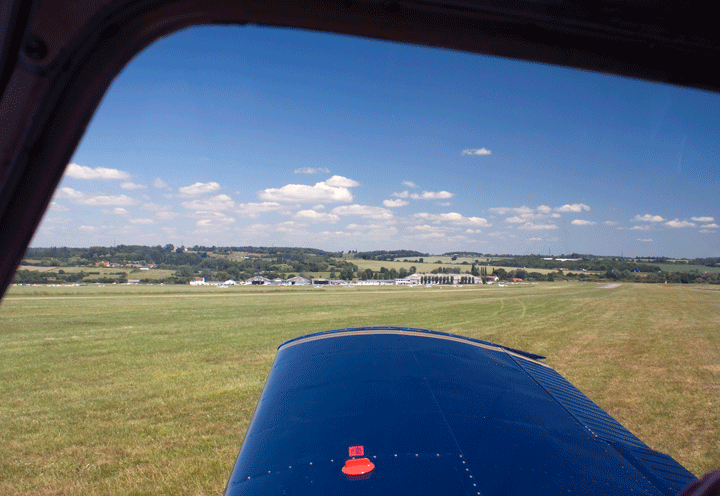
So we set the ADF and the VOR appropriately and fly them as primary instruments. Following some recent RANT practise I'm nowhere near as rusty as I thought I would be and actually it works out beautifully, the VOR nulling neatly over Bovingdon.
Following the M25 we approach Stapleford, minding the nearby Stansted Zone, and join Overhead. We descend in to the circuit and position for 04 Left, which is grass and downhill. I leave the Base leg a bit short and don't descend fast enough, so we pass over the threshold a tad fast and high which normally wouldn't matter, but this time when I flare the runway just drops away beneath me: we're not getting anywhere here. Then the Easterly wind drifts us off to the left side of the runway. It's all going Pete Tong, time to abandon ship.
Power on first, back on the centreline, carb heat off, call "going around", positive rate of climb, lose the second stage of flap, then the first stage, climb straight ahead. It's been quite a while since I had to do this for non-traffic reasons.
So back around the circuit; this time give a longer Final for better adjustment, get lower and slower and head for the upwind corner of the Threshold. A footpath crosses the approach just in front of the Threshold, and as we near a dog suddenly appears on the path and gives us a fright. We seem almost low enough to strike maybe not the dog but possibly its owner!
This time I put the wheels down solidly just inside the Threshold on the upwind side of the centre-line and we roll out gently and drama-free. Much better.
Furniture delivered and remote collected, we sit with a coffee and watch other aircraft struggling with the approach. Several bounce, some zoom, some land extremely long, some go around, so it's not just me. Interesting practise.
We decide on lunch at Sywell, because we have never been there and want to see if their new hard runway is complete.
So we taxy up the hill back to the top and take off downhill, which helps the poor PA-28-140's take-off run, then climb slowly out towards North Weald. We head North under the Stansted and then Luton Zone, squawking 0013 and listening out on the Luton frequency. Once clear of the Luton zone, we think it may be smoother on top of the scattered clouds but the 140 takes such an eternity to climb up to them eventually we abandon the idea and scoot along the underside.
Before long we are at Sywell, who tell us to land on 03 RIGHT. Noting the new strip of inviting-looking concrete we ask whether this is the correct runway. No, apparently the runway is unfinished, and if you land on it there is a huge drop off on to the grass, so the people that have landed accidentally on it have to backtrack and take-off again before landing on the grass runway... It will be available from September.
Determined to make a better job of the landing I swoop in low and slow, and drop the mains bang on the centreline of 03 grass just after the numbers. We taxy in and park, pay our landing fee and walk across to the restaurant, salivating at the prospect of lunch.
But it is not to be: one of the restaurants is closed and the other, despite being almost completely empty, is apparently "too busy to serve us, so the Kitchen is shut". Tumbleweed is blowing through the restaurant and bar, we count 3 tables that haven't got food, how on earth can they be too busy to serve us?
We leave, disgusted, having complained, to no avail, to the ineffectual management, and immediately take off again for Oxford. No sense in hanging around when you're not wanted...
The 140 climbs painfully slowly (I'm not making this up, this aircraft is definitely down on power, it's not that warm today and Sywell is certainly not High!), we set course for Banbury and then Oxford. We'll try for a straight-in approach for 19 and with a safety Pilot on board I can legitimately try an ILS approach. Oxford are busy, so we do a couple of studiously Rate One orbits just south of Banbury until they are ready, then slide down the ILS.
It's interesting: I determinedly keep my eyes very closely inside the cockpit so I am not distracted by what is going on outside (Pete will be my eyes) and fly the dot on the ILS. It all seems a lot lower-stress than it did during my IMC training: recovering from glideslope errors and keeping on the glideslope seems easier, and when I look up we are at 900ft, well below IMC minima, and spot on target.
So, over-confident to the last, I go ahead and do a really lousy final approach, finally landing half way down the runway after some ridiculous swoops and dives. Still, a smooth arrival, even if it was to the left of the centre-line. It was a great landing; they can use the pilot again. Maybe even the passenger.....
Fanatics
So I'm at a party outside in the sun; I meet this chap and we get chatting. The throaty drone of a Lycoming announces a passing aeroplane and inevitably my eyes turn skywards for a good look.
You're a pilot" he says.
"Is it that obvious?"
"Yes. I'm not a pilot but I know a lot of people who are, and I've concluded you're all fanatics. There are no part-time pilots; you either are, and are fanatical about flying, either Private or Commercial, or you're not a pilot at all....".
The conversation drifted to other topics but it set me to thinking about all the other pilots I know, and actually I think he's probably right.
We are all fanatics.
Panshanger and Stapleford 7 Jul 09
Today the weather forecast is for scattered severe thunderstorms. Normally CBs in the TAFs are a recipe for instant cancellation, but further investigation reveals that the CBs are very scattered, so I may be able to fly round them.
I need to go to Panshanger and Stapleford for vaguely work-related stuff, so let's give it a go, on the proviso that we may be diverted and/or stranded at Elstree or similar. I certainly have no intentions of braving the interior of thunderstorms, IMC or no IMC.
One up the PA-28-140 positively leaps in to the air and although it's a bit bumpy the visibility is impressive: the thunderstorms have cleared the air and London is visible almost immediately.
The thunderstorms are easy to spot, like amorphous grey blobs devouring the land, but aren't all that large around (although very tall) from up here, and easily avoidable.
This is another different perspective you get from flying: weather attains a 3D quality in the air and you can often fly around, over or under it; on the ground it just affects you.
Between the storms it's bright sunshine, and a very pleasant flight ensues; we appear to be the only non-airliner traffic in the skies.
Panshanger approaches and we change radio, but cannot raise anyone. I was warned about this on the phone and they suggested blind calls if no one answers; still, it's a bit disconcerting coming from the highly regulated skies of Oxford. I'm glad to have experience of flying in to Hinton, where there is never anyone to talk to on the radio.
So you start out with a preparatory call to see if anyone is listening, then if they're not you declare "manoeuvring for 29" then "Downwind 29" then Final 29 to Land". Easy.
Starting the approach assuming a left hand circuit I then remember it's a right hand circuit so have to correct, but 5 minutes later we're on Final for 29: a grass strip surrounded very closely by houses. Bet they love all the noise.....
Wet grass ruins braking, so I'll drop it on early and let it roll out with minimum braking. This is a good plan and before long I'm backtracking (still making blind calls) and parking in the empty Visitors park. It's just like going to the pub!
The clubhouse is empty, in fact there's no one anywhere. The radio is hanging on the wall and I don't think anyone bothers transmitting anything unless they are really busy...
During a fish 'n chip lunch in a pub a few miles away with my mate Simon (Road Safety Office for Hertfordshire, don't ya know.....) the weather breaks and we drive back to the airfield in July hail. It's hard to see the road, let alone think about flying anywhere, but it will pass (and it will pass Stapleford!).
After a half-hour delay in the office at Panshanger (quite the most relaxed airfield in the London area) having a very pleasant chat with a Gazelle pilot, the sun comes out and I (the only pilot mad enough to fly, as far as I can see) taxy out and take off. Wet grass again, so one stage of flap and expect to come off at 60Kts. Actually it's fine and we rotate at 65Kts with loads of room to spare, climb out to 1400ft to be well below the Stansted Zone, make a final blind call to say goodbye and switch to Stapleford, who actually do want to talk, which is nice.
Stapleford are rotten, I am perfectly lined up for a right base join for 22L and request as much but "we don't do right base joins here....". Miserable buggers, there isn't anyone else around. So a Crosswind join and a left hand circuit it is.
Now at last I get to fly the approach over the M25 I've itched to do during years of travelling around the M25 and, more often than not stationary in a traffic jam, watching the planes come in here. As the runway slopes up (and is tarmac then grass, a recipe for a prop strike) the angle seems weird but some fierce concentration puts the wheels gently on a third of the way down the tarmac.
Steady braking stops the aircraft before we run out of tarmac and we manage the recommended 45° slow cross on to the grass, yoke back in the stomach to minimise the prop strike risk, then backtrack on the grass and park up.
The weather is now beautiful but absolutely everyone else is firmly on the ground; flight training instructors all doing Ground School with their students in the café and looking at me as if I'm completely and utterly crazy.
Will someone please tell Stapleford Flight Centre to wash their Cessna 152s? They look awful.....
After some business in Romford (more massive thunderstorms) and a taxi ride back (and people think flying is expensive...) I arrive back at Stapleford at just before 7pm. The AFE Guide says that Stapleford's Operating Hours are 8.30am to sunset, but checking with Oxford Ops (as we're running late) they tell me Stapleford are about to close due to the weather. Better get a move on!
Start up, taxy out to the bottom of the slope, power check, take off up the hill, follow the circuit round, say g'bye to Stapleford then head off West for home in the sunshine.
The thunderstorms are still around but have reduced in size as the evening has progressed; it is very easy to avoid them now.
Farnborough North have simply gone home, so we talk to Luton who are very unstressed and helpful. Our calls are interspersed with EasyJet Heavies coming in from Majorca and Benidorm on Luton's ILS.
West of Bovingdon we are freed from the London TMA and may climb but a huge thunderhead is directly ahead; looks like a divert North may be necessary.
But on closer inspection it turns out to be two separate storms and we can slip between them in to the bright evening sunshine of Oxfordshire, a cruise descent for a Left Base join for 19, roll out Final with a surprising amount of crab required, aim for a third of the way down the runway, kick off the crab and aim to be straight and on the centreline when the mains touch... yes, just there, feel the wheels kiss the tarmac, and we're Home.
But being brutally honest, I suppose I'm just not quite confident enough in my own IMC abilities to want to deliberately spend long periods IMC, especially doing formal procedures, just yet.
That's not to say I have let the IMC skills lapse: I use the radio Nav beacons as primary instruments, I fly quadrantal levels above 3000' (and to within 100ft), I do practise procedures and Holds in RANT. But doing it all together "outside the classroom" for an extended period in real IMC has thus far not been a high priority.
I suppose one concern is the difference between using foggles and having a clear view ahead in to the swirling clouds: I'm concerned this will put me off or alter my ability somehow to trust the instruments in that very necessary Limbic sense.
So a text from Pete offering a right hand seat one evening for a practise fully-IMC flight in the Mooney is one to be accepted gratefully: I suspect I will learn a very great deal.
The weather has alternated between being perfect (i.e. cloudy at 1,000ft) and sunny with a 4,900ft cloudbase, so we're not sure if it's worth going until 5.30pm when it clouds up nicely, and we uncover and fire up the Mooney at a cloudy 7.00pm.
Pete does all the instrument and radio ID sanity checks I would expect and we're all ready to go when the Tower cancels our Take off clearance and we Hold on the runway for a large flock of birds that has been scared up the roving runway inspection vehicle.
Take off clearance restored, we climb in to the grey murk at 1,000ft. Interestingly, the constantly shifting scenery out of the windows is nowhere near as disorientating as I thought it might be, which is a relief. We climb to FL30 and head for Westcott on the NDB.
With the flight programmed on the windscreen Garmin 496 we can double-check to ensure the NDB is doing sensible things and we have the wind bracketed nicely before long. At 150Kts Westcott turns up quickly, our arrival confirmed by the VOR tuend to Daventry. We blow through the correct track turning North for Daventry, but quickly correct and cruise Northwards with VOR, NDB and GPS all in sync. Climbing to FL45 we soon emerge from the banks of cloud and are skimming between the layers with the sun peeping through. We have rainbows and the pseudo-landscape of the clouds below us for company; it's very pretty up here.
As we approach Daventry we re-enter the clouds and "cut the corner" as we are heading West: no point in overflying the beacon in zero visibility. Oxford's radio is quiet but that doesn't mean nobody is out there.
Approaching Morton we are once more in and out of banks of clouds; we ask Oxford for a Hold at the OX beacon and we are cleared inbound for a Direct Entry. It will be interesting to see how Pete handles this...
Inbound is good and we arrive neatly directly over the beacon then head outwards on a course designed to take us out the inbound corner of the Hold. This turns out to be somewhat inaccurate and as we roll out inbound towards the beacon we are a fair way too far East, so a bit of scrabbling around is required. Having the GPS as a backup is enormously helpful because it confirms what the ADF is telling you about where you are: a very useful situational awareness tool.
Overhead the beacon we call Beacon Inbound roll out on the correct heading and cruise-descend whilst doing Downwind checks. Start the Base Turn at 6.5d (it's nice to have all the instruments working properly!), call Base Turn complete and descend down the approach procedure steps, starting to break cloud at 1,200ft QNH.
The IMC minimum on this NDB non-precision approach is 890ft QNH (690ft above ground), and as we watch the runway lights approach at that minima it's really very close and you are very low. I can understand why the IR minima, 200ft further down, or 440ft above ground, requires so much extra training: to be confidently flying blind at 440ft above the ground you need nerves of steel, I reckon (or no nerves at all?).
We have planned a Missed Approach for this one, so we climb back up in to the clouds. For a moment they break and I realise the Hold is performed over North Oxford: well of course I knew that but had just never actually seen it.
Back through the Overhead we then descend for the ILS approach. I notice lots of careful early trimming going on, useful to reduce the workload later: a Good Tip. Then we're stable on the ILS and at last I can get to see what one dot's deflection left or right means in practice: not a lot. So long as you are within 2 dots you're very close to being lined-up in reality.
We go visual at 1,000ft and the ILS minima take you virtually to the threshold. If you couldn't see the runway lights at 100ft above the ILS minima then you really shouldn't have been flying at all that day. The only times I have seen a cloudbase that low have been in fog.
So all in all a very useful exercise: nothing there I wasn't confident in doing, no big problems, now I think we might do it in reverse with Pete as Safety Pilot and me in the left seat.
Bembridge 6 Aug 09
John and I are hoping to get to Bembridge for lunch today. It's sunny but the weather forecast is for two bands of rain coming through. The first will be light but the second, forecast to come in later, will be heavier and may contain thunderstorms. It's one of those days when most people err on the side of caution and don't fly.
We discuss it and with the aid of the Met Office weather radar decide on a plan to play the forecast: we will endeavour to go to Bembridge for lunch through or around the first band of rain, have lunch while the second band comes through, then go to Compton Abbas and take tea whilst the second band clears away from Oxford.
John is keen to navigate us to the Isle of Wight using traditional VFR methods so off we go with stopwatch and compass: John navigates and tells me where to fly.
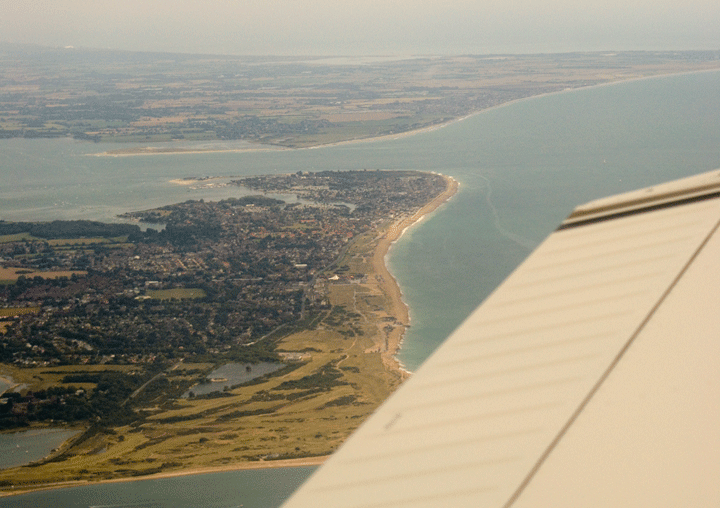 Almost immediately we encounter the first band of rain, but it is very light. The majority is to our West and as we head further South it ceases but we find ourselves, having climbed as high as possible to avoid gliders from Lasham, VFR on top at FL40. So once past the gliders we notify Farnborough and descend through the clouds to find that our stopwatch and compass work has succeeded and we pop in to bright sunshine over Havant right on course. Heading out over the Solent we change to Bembridge, join Downwind and turn Base over the sea.
Almost immediately we encounter the first band of rain, but it is very light. The majority is to our West and as we head further South it ceases but we find ourselves, having climbed as high as possible to avoid gliders from Lasham, VFR on top at FL40. So once past the gliders we notify Farnborough and descend through the clouds to find that our stopwatch and compass work has succeeded and we pop in to bright sunshine over Havant right on course. Heading out over the Solent we change to Bembridge, join Downwind and turn Base over the sea.
This is the runway I nearly overran in a C172 a couple of years ago having misread the approach, so am determined to get it right this time, and a tightly controlled and carefully trimmed descent has the main wheels neatly on the numbers and us stopped by the midpoint taxy exit. Time for a Crab & Lobster lunch in the warm sun.
On returning to the airfield we can see the second band of rain threatening us to the West: we check out the Met Office's weather radar on the restaurant's nifty new iMac and conclude that going West is going to take us through the front. Compton Abbas tell us they have heavy rain and aren't flying so we decide on a flexible plan that takes us West in to the rain to Stoney Cross. If, at any point, we decide the rain is too much we will turn round and fly East. If we get to Stoney Cross and the weather is too bad to go further West we will go North back to Oxford, then if the weather is too bad there we will either go East to Booker to wait it out, or climb as high as we can and go over to Gloucester to wait for Oxford to clear. It's a Plan.
We take off and fly straight in to a wall of rain: excellent experience; the visibility is reasonable so we head West to The Needles then North to Stoney Cross. Solent Radar hand us off to Bournemouth and we track through rain-sodden skies over the heathland of Southern Hampshire at 1500ft. Nearing Stoney Cross we conclude West looks threatening so turn North and track up between Solent and Boscombe Down. No one else is flying, so the radio is quiet. We are in and out of cloud at the MSA of 2300ft below the Solent CTA with sufficient VFR moments to have an idea of what we are flying over as well as a radial to Compton and the GPS.
Exiting the gap North of Winchester we spot the A34 and head North once more. The weather slowly improves until we are in clear air under a 4500ft overcast by Newbury; looks like our diversions won't be necessary after all.
Switch back to Oxford and ask for a Right Base for 01, cruise-descend from Abingdon onwards and drop the mains on one third of the way down 01, but still just to the left of the centre-line. Got to stop doing that!
As we shut down the aircraft, however, the rain arrives in massive sheets and we sit for 30 minutes misting up the windows, watching it come down, before we make a dash for the car. Looks like good timing!
At each point we had a plan, sufficient fuel and qualifications to get us out of trouble, and we managed to extract a decent day's flying from a pretty awful weather forecast.....
Microlighting Aug 09
I looked at learning to microlight (it's a lot cheaper than Group A aviation) before I got my PPL but if you're heavier than 95Kg your options become very limited, so I have tended to avoid this form of aviation so far. But this is about to change...
John has a Tecnam P92J in to which he reckons he can squeeze his slightly-more-than-95Kg, my quite-a-lot-more-than-95Kg and some fuel for a sunny Saturday evening bimble over Buckinghamshire.
He keeps the Tecnam in an Intervention store at Oakley airfield (once touted as a possible London airport, being exactly half way between the Capital and Birmingham, but now bisected by high voltage power lines) where the doors are narrower than the wingspan so he has a trolley on castors that allow him to ease it in and out at an angle.
The Tecnam appears flimsy compared to a Group A aircraft but the structure is strong and there is as much room in the cabin as a Cessna 152. Having inserted myself in to the right hand seat we start up (Rotaxes are pretty quiet) and taxy out on the cracked, weed-infested concrete. No taxy clearance required, we power-check on a particularly weed-ridden area and turn on to the marginally-tidier 120m 20 runway, drum-drumming down the expansion joints until at 40Kts we are suddenly airborne and climbing out. At this point it actually feels just like a normal aircraft and we are climbing at a respectable 500ft/minute 2-up, so none too shabby performance either.
Levelling out at 2,500ft we do some general handling, John ensuring (as he has never flown it this heavy before) that it will perform OK, before we depart the Oakley area and head North for the gliding site at Haddenham (where I saw a Mooney beating up the field at low level the last time I drove past), then to Waddesdon, where a wedding is occurring, and then John lets me fly it.
It's nice having a stick again: I haven't flown one since my gliding days, and it's so much more natural than a yoke. We try some climbs, descents and turns, then some steep turns (we either lose speed or height, there is insufficient power to maintain both). The visibility is excellent and it doesn't seem slow; we're averaging 65-70Kts.
We fly over Stokenchurch, dodging the ubiquitous C172s heading for Wycombe, and up the M40 towards Otmoor, looking for a farm strip I know exists up here. We orbit over our old house and far too soon we've used 14 Litres of mogas (in 50 minutes!) and need to be overhead Oakley, so John takes it and we descend for a downwind join for the other runway 29. John's gum-chewing reaches fever pitch as we turn Final, but it's drama-free as we touch down a third of the way down the barely-visible cleared section, and roll out under the pylons (could make for an interesting Missed Approach....) and back to the barn.

|
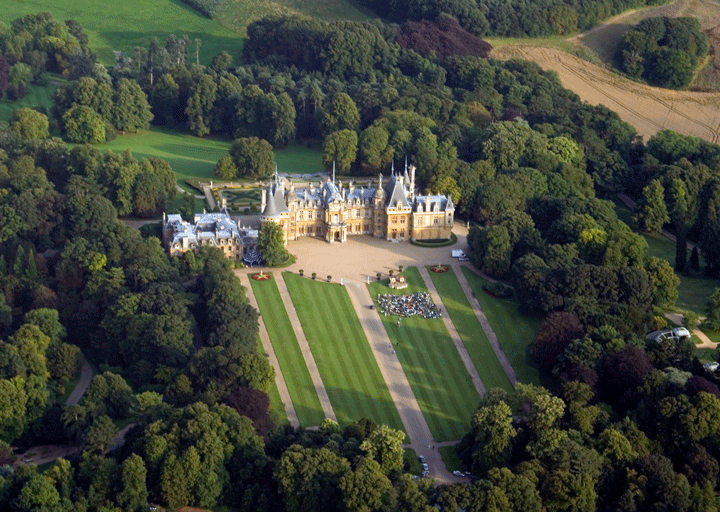
|
|---|---|
I could be tempted by the microlighting life: the engineering regime is hugely more relaxed, and you can even (shock horror!) add new instruments to your panel yourself. Current rules allow only Day VFR flight (although that may well soon change), but if you are flying from a strip who's going to know? With 2 GPS's you could make up your own (hugely common in the US) non-precision approach plates for the strip. The weight remains a problem, but give it a couple of years and the CAA will be bulldozed in to accepting the European LSA category which has a higher maximum weight. So this may be the way to go.
Shobdon 18 Aug 09
Today I'm taking a couple of relatives, one who is thinking of learning to fly, out for some sightseeing and to Shobdon for tea.
Check the W&B (fine as we are with tabs fuel, a bit, ahem..... dodgy with full fuel), load up the PA28-180, and take off. As these guys are new to aviation they get the full passenger briefing, safety briefing and Nav briefing designed to add a sense of calm and professionalism to the process (although I suppose the pilot wearing shorts doesn't help...).
They live near Hook Norton so a right turn out, good view of Blenheim Palace, then NW between Charlbury and Enstone, watch out for planes from Enstone and keep up the good lookout as there are a lot of aircraft out here.
Once found, we orbit over their house (this is why we study steep turns) until they feel sick, then move on West.
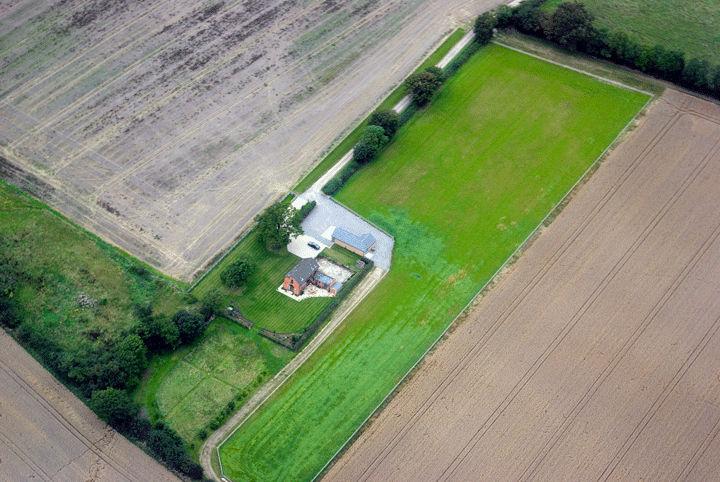 The normal manoeuvre at this point is to switch to London Information West for a Basic service, but although I can hear people talking to them I cannot hear their transmissions, so after one exploratory call we abandon and travel non-radio for a while.
The normal manoeuvre at this point is to switch to London Information West for a Basic service, but although I can hear people talking to them I cannot hear their transmissions, so after one exploratory call we abandon and travel non-radio for a while.
Alistair flies us, under clearing skies, to Hereford where a low orbit over the city centre shows us that there is a lot more green in the urban area than you would believe from a ground level visit. Then we head North West for Shobdon and attempt to contact them. We can hear other aircraft on the frequency and in the circuit but they are not transmitting, so we make blind calls all the way in to 27LH.
As we turn Final I have to put a big crab on to stay on the centre-line, then catch a lot of wind shear from the treeline. With 4 up the rate of descent is too high; I flare too early and end up nose-high on the back of the drag curve at 10ft off the deck with the stall warner going. I've been here before, just not for a long time, and I know it precedes a hard landing. I am NOT going to let that happen again, so we abandon with full chat and tear along the runway in ground effect for another go. Not pretty, but this is a habit I have broken.
Next time around we are more under control and land firmly but neatly on the very-newly-surfaced runway (the tarmac machines are still sitting at the far end), backtrack and roll in to park. That's better.
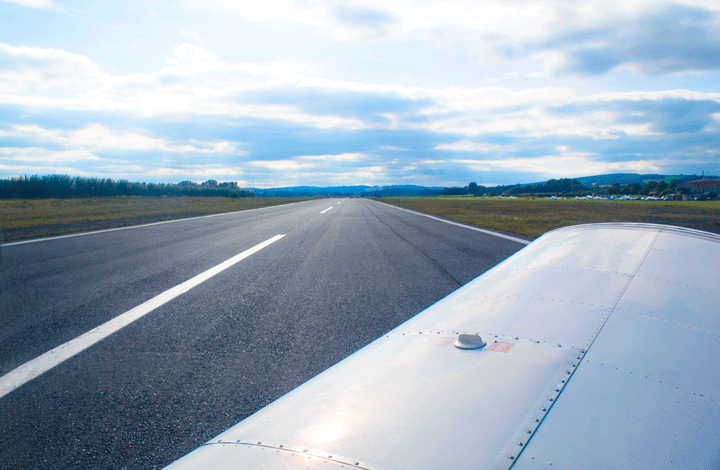 After a cup of tea and some photos we mount up once more for the return leg and head South East for Malvern. I never tire of circling over Great Malvern: it looks different every time and I enjoy the walkers on the top looking up and waving ("Piss off you noisy bastard!").
After a cup of tea and some photos we mount up once more for the return leg and head South East for Malvern. I never tire of circling over Great Malvern: it looks different every time and I enjoy the walkers on the top looking up and waving ("Piss off you noisy bastard!").
Alistair flies us East to where London Information have asked us to report North Abeam Gloucester but try as I might I cannot hear them, so make Blind calls informing them I am changing to Oxford and squawk 7000 - they can call Oxford if they are concerned. Change to Oxford and tell them of my dilemma but they don't hear from London Info so they must have heard from us.
Over The Cotswolds is featureless: I suffer from a moment of navigational panic, but a careful cross-check of Honiley and Compton VORs reveals we are exactly where we think we are, and soon Oxford hoves in to view for a Right Base join, high all the way down the approach and land bang on the centreline, a little wiggle and we're rolling and home again.
Treasure Hunt Sep 09
John's Tecnam is now fully operational, and Oakley airfield are having an open Day, with visiting microlights, a spot landing competition, flour bombing and an aerial treasure hunt.
Oakley is an interesting airfield: an ex-bomber field almost entirely gone to grass; the runway has never been dug up but has disintegrated slowly. An increasingly active microlight group is slowly clearing the runway: when I used to live down the road a few years ago they had a very small runway, but now it's 150m or so. Many of the concrete blocks are in reasonable shape and with attention to the inter-block gaps probably 800m could be opened up, allowing larger aircraft in. One day.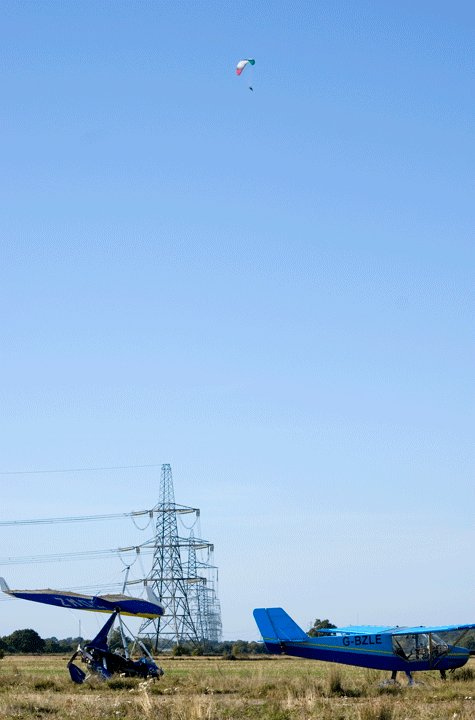
Group A pilots are notoriously sniffy about "home-built" microlights, but many are now factory-built and the whole artificial microlight / Group A partition is about to be blown wide open by the American LSA standard and moves by the EASA and the LAA to hugely open up what "microlights" are allowed to do. The 95Kg seat load has already gone, the max all-up weight of 450Kg is about to disappear, the restrictions in flying them to Europe have gone and, within the last few days so have the restrictions on flying them to The Channel Islands. The last major restrictions are Night and IFR flying, and negotiations between the LAA and the CAA to remove the IFR restriction are apparently proceeding. Apart from flight training, I can see microlights having equal status with Group A aircraft in a few years. At 17 Litres of unleaded car petrol (so £18) per hour the economics cannot be beaten.
Watching the microlights fly and chatting to the pilots makes me aware that this is much more grass-roots flying than I am used to. These guys have seriously cheap flying, using car petrol and no landing fees. Some of the aircraft cruise at 125Kts and Oakley is non-radio, so there are no official opening hours. Very accessible aviation (OK, some of the aircraft do look pretty homebuilt.....).
We start the Treasure Hunt as the flour bombing ends: it has been a beautiful mid-September day and it's just starting to cool off. John's confidence, pre-flight checks and familiarity with the plane have improved hugely over the last few weeks, and despite being just over MAUW on take-off we are soon in the air and headed for the first turning point.
The heading I know we need to steer (as I know where the turning point is) does not match even approximately with the compass (which should have given us a clue.....), but within a few minutes we are overhead and turning North. Apparently we need to find a farm with a pond and we have a photo of what it looks like from the air. It's along a 350° track from the turning point.
But after 20 minutes we hit Silverstone and I know that's not right, our track is definitely wrong.
We turn for the next point, using Milton Keynes as our reference and head South East to the next point. Again we miss it; are we idiots?
Nothing seems to match up and whilst we know where we are we cannot find the water-towers and sewage farms we know to be there.
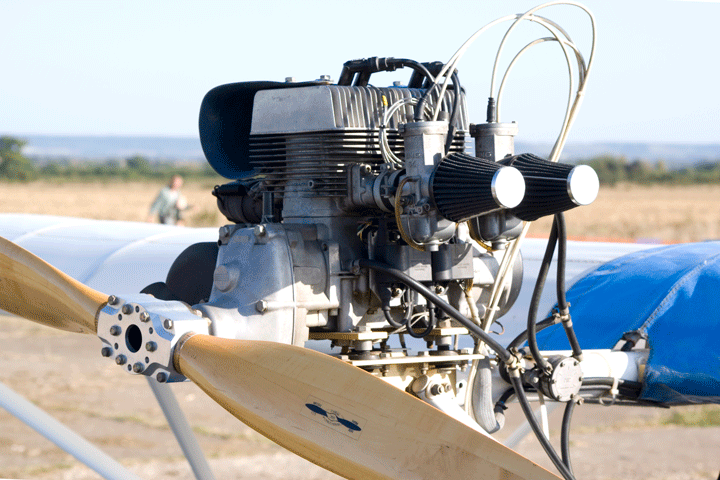 So we ignore the compass and concentrate on flying the course on the map. From this we deduce that the compass is out by about 25°.
So we ignore the compass and concentrate on flying the course on the map. From this we deduce that the compass is out by about 25°.
Once we know this we easily find and count the locks at Stoke Bruerne, then break out the Garmin GPS and use the virtual compass on that for accuracy.
We then much more easily find the bridge at Buckingham and the silos at Bicester. John needs to do a compass swing...
Heading back we are running out of light (I mentally run over the fall-back plan: a divert to Oxford, which has lights. A £16 Landing fee is better than trying to land after dark at an unlit airfield with power pylons around...).
John does a Full Monty Overhead Join at Oakley (I'd have joined Downwind, 'cos I'm lazy...) and by the time we are on Final it's really getting dark.
Despite this, John does a really nice landing and we put the aircraft away as the need for car lights becomes increasingly apparent (there's no electricity in the barn), and congratulate ourselves on a really enjoyable day.
Now I am hugely in John's debt.
It turns out the compass is massively wrong, and John has it serviced. Strangely, from then on, his long-distance navigation becomes much more accurate....
Wolverhampton 17 Sep 09
I have promised Luke a flight, and all our company work has been done today so we book out a PA-28-180 and decide to go to Wolverhampton: I've not been there before and it looks nice.
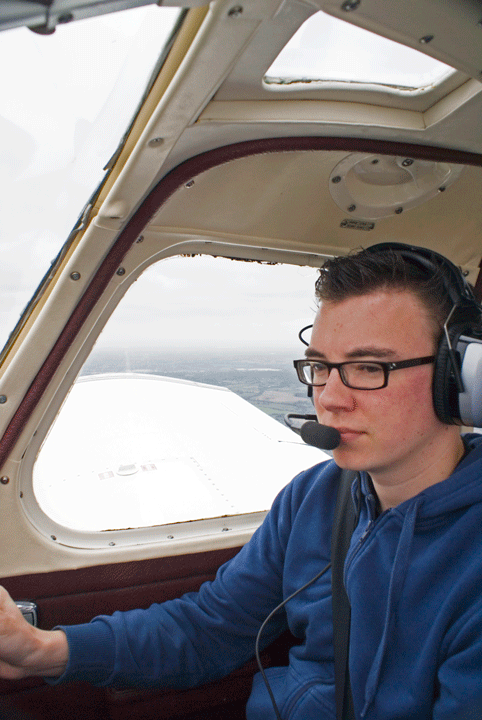 Start up, taxy out and get stuck at the Hold behind an HS.125 business jet waiting for clearance through the Brize Zone. Me, I'd have blasted off and gone over it! Thoughts of Wake Separation occur: he is quite heavy and will generate some vortices on take-off, so I need to get in the air before his take-off point and ensure I am upwind of his climb-out. Two-up the PA-28-180 climbs fast, we don't hit his turbulence and are soon overhead Banbury for some steep turns over Luke's house. There is no working VOR on this aircraft but it has a flashy new radio, which is a massive improvement on the old one. Apparently the VOR is next on the improvements list, which will make a big difference.
Start up, taxy out and get stuck at the Hold behind an HS.125 business jet waiting for clearance through the Brize Zone. Me, I'd have blasted off and gone over it! Thoughts of Wake Separation occur: he is quite heavy and will generate some vortices on take-off, so I need to get in the air before his take-off point and ensure I am upwind of his climb-out. Two-up the PA-28-180 climbs fast, we don't hit his turbulence and are soon overhead Banbury for some steep turns over Luke's house. There is no working VOR on this aircraft but it has a flashy new radio, which is a massive improvement on the old one. Apparently the VOR is next on the improvements list, which will make a big difference.
Heading North West Luke flies us (creditably, it must be said: he sails and has been practising in Flight Simulator) around the West side of Birmingham. The radio is us, one other GA type and a number of regional airliners. We talk about flying out of balance and a demonstration of flying crabbed generates a worrying smell of petrol in the cockpit (very weird). Then we swap to Wolverhampton A/G and settle down for a crosswind Join for 34 at Wolverhampton.
Bit of a crosswind but a creditable approach, good speed control and no crab at the last moment make for a good arrival; we expedite as requested, turn off on to the other runway and taxy in.
Wolverhampton's control tower has the most worryingly rusted 1940s-vintage external steps I have ever seen. H&S, where are you when we need you?
Right next to the control tower and inside the apron is a small building housing good grief it's an IT support company, they must all be pilots.... How cool an office is that?
I am jinxed when it comes to airfield cafés: the BBC are in town with a 50-strong film crew today filming "Survivors" around the control tower, complete with explosives. It looks like fun but it means the café is closed. As consolation they offer us a free cup of tea in the office, which actually is all we wanted anyway, so we're happy.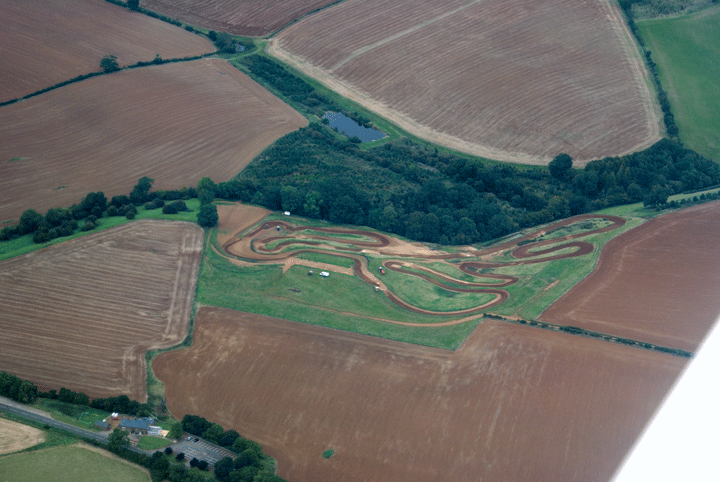
Back in the aircraft, we fire up and take-off, following a more direct route home.
Approaching Oxford from the North-East the Cotswolds are quite featureless until we pick up Farmoor Reservoir in the far distance, then Chipping Norton closer at hand. Join crosswind for 01, run down the approach and drop it neatly on, roll out and taxy in.
On the apron is a recently arrived all-green UH-1 Iroquois helicopter with several green-overalled chaps getting out; they have the biggest grins on their faces you will ever see. Anyone who has ever watched the film Apocalypse Now understands the appeal of the Huey, with its huge rotor blades.
What wouldn't I do for a ride? Wop Wop Wop....
Henstridge and Compton Abbas 12 Oct 09
It has occurred to me that for a while I haven't done any Zone Transits or MATZ penetrations. I haven't been consciously avoiding them, I just haven't needed to: I have either gone over, under or around any controlled airspace I have encountered.
Today is a very beautiful October Monday: without the summer thermals it will be a smooth flight. We would like to do some photography in Dorset and, being a weekday, the military installations will be Active. So time for some planning using the most excellent SkyAngel (hugely recommended, but for some reason it thinks Lyneham Zone's radio frequency doesn't exist). This can download routes to the Garmin 296 and generate wind-adjusted plogs. No more whizzwheel!
We'll go West to photograph Mother-in-Law's mill house just outside the top left hand corner of the Brize Zone, then head South for Malmesbury, avoiding Kemble's ATZ and plan for a Zone Transit through Lyneham, then down to Henstridge from there.
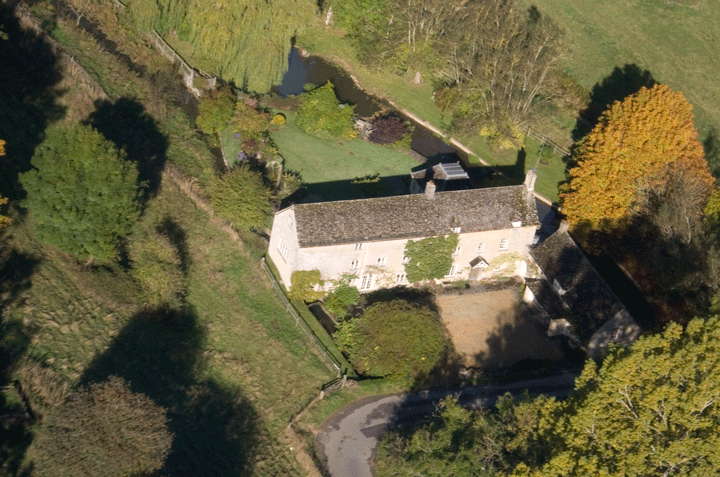
Today we will take a PA28-140 with a new engine, so we must be gentle with it, and not expose it to shock-cooling. Opening the engine cowling, everything looks neat and new, and smells of new engine. This should be interesting (although, statistically, it's also most likely to fail in flight. We won't tell the [nervous] wife that....)
Get in, start up and push the transmit button to get taxy clearance.
But there's just a hole where the PTT switch is meant to be.
Ay? Am I being stupid here?
Nope, it really is missing.
We try using the passenger yoke PTT with the headphone leads swapped, but realistically I can't fly around like that so we shut down, call in and they lend us a repaired one with a bit of velcro that works flawlessly for the rest of the day.
The new engine thrums smoothly as we taxy out in the sunshine. It's nice and warm in the cockpit and we line up and take-off, turning West for Charlbury and switching to Brize for a Basic service.
However, they can't see our Squawk, so I look more carefully and see the "Unserviceable" notice that is taped to the front of the Transponder box. Well, that would explain it..... But it wasn't in the Tech Log!
Brize can still see us OK and are happy for us to be "Negative Transponder" so as we reach the corner of the Zone we advise them and descend to beat-up the mill.
Having frightened the neighbours a bit we head South, switch to Lyneham and ask for a Zone Transit. I've preconfigured the plog for Malmesbury, the planned Control Zone entry point, to be a turning point so the GPS gives us a time estimate; much easier than working it out manually.
Lyneham are deathly quiet: nearly all their resident aircraft are of course in hot, sandy places at present, and we only hear one other aircraft on frequency. They are happy for us to Transit at 2,500ft, even without a Transponder, as it gives them something to do, and before long we pass what seems like very close to Lyneham, which is surprisingly big, and then over a large number of typical towns-with-roads-and-rivers that make VFR dead reckoning nav so impossible before crossing the A30 and talking to Henstridge.
Henstridge reckon the runway is 25 LH so I assemble the necessary mental map, noise abatement chart unfolded on my knee, and start a cruise descent; whereupon they call back and swap runways (there is very little wind). So now we're on 07 RH. This time I simply draw the circuit on the noise chart and join crosswind.
Some of the villages around Henstridge are apparently very noise-sensitive, so we have to fly an offset approach (glad I've done this before) for 07, which looks short so I end up doing my "panic running out of runway" approach resulting in too high a rate of descent at flare. Catch it with a bit of power, not too much to balloon, and we settle on the runway and roll out. That's how you deal with that litle problem, now I've just got to start landing on the centreline...
Henstridge is dead: we are the only people in the circuit or on the airfield although it looks like they are busy at the weekends. Only the manager is there, and we settle in the sun for a coffee. Nice little airfield: very friendly.
As we leave the canteen he asks us if we can do an early right-turn out for noise abatement. Any excuse for hooliganism, of course.....
 Backtrack 07, power checks at the Threshold, then roll. 65Kts, get her airborne, and then we are Early Right Turning before the end of the runway: right round the control tower, off the field at 75ft, don't pull too hard and do an accelerated stall, just a nice Rate One low-level turn then climb out between the villages South West. Leaving the frequency he thanks us for our early right turn, a note of amusement in his voice...
Backtrack 07, power checks at the Threshold, then roll. 65Kts, get her airborne, and then we are Early Right Turning before the end of the runway: right round the control tower, off the field at 75ft, don't pull too hard and do an accelerated stall, just a nice Rate One low-level turn then climb out between the villages South West. Leaving the frequency he thanks us for our early right turn, a note of amusement in his voice...
Our friends have a cottage South of Henstridge I've located pretty accurately on the GPS and we find it easily, swoop low and photograph it nestling in a remote corner of Dorset in the sun, then climb out East for lunch at Compton Abbas.
To our amusement some plonker comes up on frequency asking for Sywell (which is 95nm from here). The two airfields share a radio frequency, so he's either seriously lost or has a seriously powerful radio. What sounds like an eight-year old girl answers from Compton Abbas. Nessie and I look at each other in amazement: isn't she too young to be manning the radio?
Within a few minutes we are on a Crosswind Join for 08 at Compton Abbas, the runway where the ground rush is extreme and the hillside comes up to meet you. Hold your approach, ignore the ground rush and drop it on a third of the way down the runway, where the runway falls away as you flare and you wonder when the flare will ever end, until you realise you are actually on the grass and rolling out.
As Peter Gabriel once said, It's One o'clock, and time for lunch (but then he was a lawnmower...).
And we get to meet the eight year old on the radio who, it transpires, is a very pretty sixteen.
The plan is to leave Compton Abbas, fly North East and ask Boscombe Down for a MATZ penetration to overfly Stonehenge, to neatly complete our transits 'n penetrations refresher. So we depart Compton Abbas on 08, and the draggy grass and uphill runway keeps the poor 140 grounded, even with the nosewheel off, until eventually I haul it off against the stall warner and bank to avoid the trees on the take-off path before we finally breast the ridge and climb away.
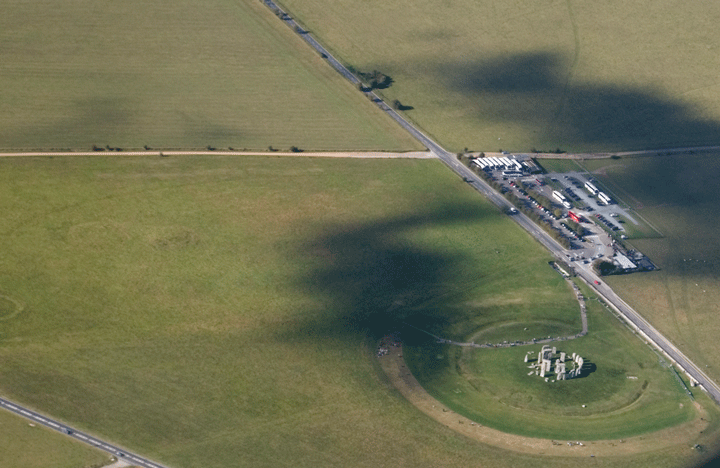
|
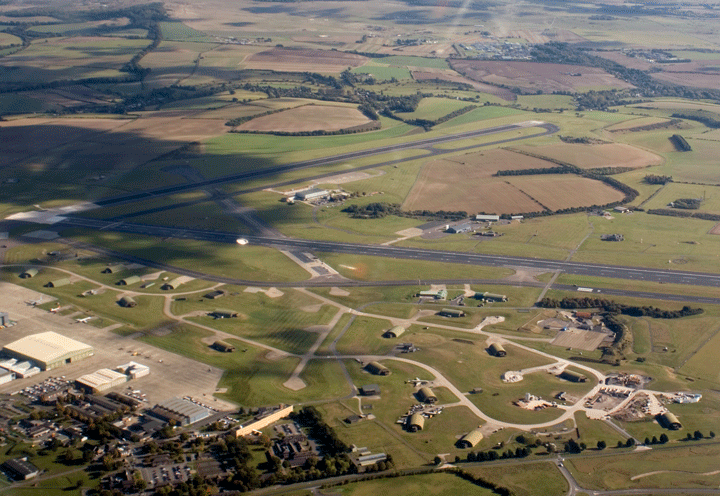
|
|---|---|
Boscombe are busy but happy to comply with our request provided we maintain 2,500ft which is, frankly, a bit high to photograph Stonehenge from. We do a couple of orbits trying to get a better shot until a harassed controller asks if we are "finished with Stonehenge yet". This is obviously a barely-concealed "get out of here" so we depart for Thruxton, weaving around the two ATZs whilst maintaining a strict 2,500ft then turning North. Boscombe ask us to report crossing the A34, which we will not do until Oxford, so we will report once well clear of their MATZ and go talk to Farnborough.
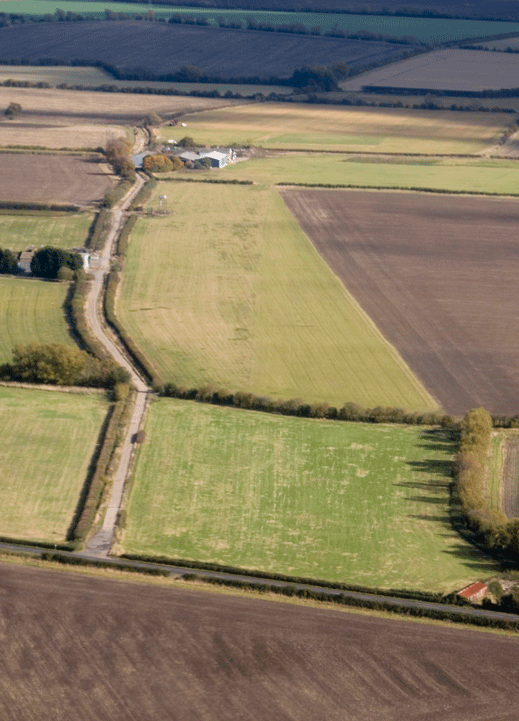
And this is where it gets interesting: soon after clearing the MATZ we request a change en route to Farnborough, we request again and again but they can't hear us. I don't like leaving a frequency without a proper handover, quite apart from anything else it's poor airmanship, so resolve to ask Farnborough to ensure Boscombe know we are OK and with them. But on changing to Farnborough we just can't get a word in edgeways they are so busy, and after 15 minutes we are so close to Oxford we decide to change straight to Oxford Approach as we cross the M4 Northbound. And of course I forget to tell them about Boscombe...
So, a low-level strafing run over an interesting local strip, a client's house (they're in South Carolina), and our house before pulling up to avoid the helicopters over RAF Abingdon, climbing out and calling Oxford for a Right Base join for 01. Start the approach a bit high but drop in to the cone for a gentle, controlled landing and roll out.
It's only later we discover Boscombe thought we had gone down and had been calling Oxford.
Lesson learned: you need to get a formal hand-off or tell the next ATC unit you speak to that you didn't get one from the last unit and could they just give them a call and put their minds at rest.
Bembridge Oct 09
We need to be in the Isle of Wight for a business meeting, and as those ferries are so expensive and time-consuming the client is going to fly me down in his Columbia/Cessna 400. It's a grey day, overcast at 1,800ft or so.
Backtrack 19 (surely not, with this power/weight ratio?), then the kick in the back as we go to full "40gals per hour I love Saudi Arabia" throttle and by about halfway down the runway we're off the ground.
I was taught that for safety, once out of ground effect one puts the aircraft to best climb speed to gain as much height as soon as possible. In an engine-out scenario height is safety: once above 500ft your options may include a turn to get back to the airfield, even if it's a bumpy off-runway grass landing.
But my pilot opts for speed, keeps the nose right down and we scream across the treetops at approaching 120Kts, bank left to avoid Brize's control zone and then start to climb. Weird: just not the way I would have done it.
We change to a Brize Traffic Service immediately for a bit of radar help up through the clag and by 3,000ft we are VMC on top, in the bright sunshine, on autopilot and at 170Kts tracking the CPT VOR beacon.
He has TCAS and the amount of traffic in the vicinity is worrying, but we can identify the possible conflicts long before Brize, and then Farnborough, advise us. The same screen gives us up-to-date METARs and TAFs, and allows e-mails via the Iridium satellites. Nice system. But could I handle it in the event of pilot failure?
30 minutes later we are descending for a cloud break overhead the Solent and we pop out in a gap between two clouds before manoeuvring around the clouds (I love this bit) for a Downwind join for R12 Bembridge. He flies the circuit fast and tight, then pops the airbrakes (nose on the windscreen job), but we still end up fast at the Threshold, and the landing is a bit bumpy (not that I could have done any better!).
An hour and a half, one wireless survey and two fresh dressed local crabs later we're firing up and taxying out. But where I normally do my power-checks he taxys past and we backtrack. Perhaps he'll do his checks on the runway (or even rolling, I've seen that done), but no, he completely misses them. Worrying.
Another yeehaw run down the runway (the digital speed tape disagreeing wildly with the analogue instrument at this point) and we're in the air brushing the tops of the mobile homes off the end of the runway, then the trees, and suddenly we're over the water again and climbing. Not much height for error there, but I suppose the speed would have carried us over the tops and in to the water in the event of an EFATO?
Back in to the clouds, more sunny VMC on top on autopilot and a radar-free (with TCAS you don't really need a Radar service so much) IMC descent over Bagley Wood and the Oxford ring road brings us to a downwind join for R19 and a neat approach and landing.
It's always interesting to fly with other people: they do things differently because they have more experience (or less) or because they own their own aircraft or habitually fly IFR or whatever. But you can learn a lot from flying P2.
Wycombe 12 Nov 09
I've never flown to Wycombe Air Park.
That may appear crazy but there are many semi-local airfields that feel just not quite far enough away to be worth visiting.
However, today I'm a bit strapped for time, and just feel like a "keep in practise" low-stress VFR cup of coffee somewhere not too far away, on my own for once. So, Wycombe Air Park it is.
I seem to be having troubles with my take-offs recently: I just can't get the plane to take-off by itself and have to haul mightily back on the yoke when I feel it really ought to be flying time. I know this isn't right, so today we will experiment with a different take-off technique: hold the yoke back from the start of the take-off run and see what happens.
What happens is that we accelerate a great deal faster, at 50Kts the aircraft starts to float, and at 58Kts it zooms in to the air quite suddenly. Without moving the yoke at all we are at best climb speed and the take-off run has been shortened (the GPS later states 318m). Ah ha!
It's quite bumpy up here, and I'm just wondering about the weather forecast, which is for strengthening winds to 27Kts, when we top 1,00ft and it just stops, leaving us in very smooth air. Mmmmmmm.....
Trim out at 3,100ft (just above Benson's MATZ stub), switch to Benson (strangely enough, I've never before had cause to speak to them) and cruise Eastwards hands-off; very relaxing.
It's still quite early in the morning and The Chilterns are misty in the hollows; the sun is in my eyes and I can't see Booker until I am quite close, so an orbit and radio call, join downwind RH for 24 and cruise across High Wycombe.
As we drop below 1,000ft the lumps and bumps start again; it must be ground turbulence.
I've driven under this approach so many times on the M40, the crossing aircraft always seem very low, and turning Final I realise why: the start of the runway is just beyond the fence, so by the time I'm over the trucks and coaches I'm virtually flaring.
I'm aiming for a really gentle touch-down and keep the back pressure coming until the mains kiss the tarmac, then aim to keep the nosewheel off the ground for as long as possible. Smooth as silk.
Backtrack, as the grass is waterlogged, and taxy in for coffee.
Half an hour later, suitably refreshed, we are ready for the return journey.
This time we try even more extreme back-pressure: I've got the yoke on the backstop all the way down the runway; we stagger in to the air at 50Kts and although the stall warner doesn't go, it feels like shit and we wallow and begin to sink again, so maybe that was a bit too much. Release a bit and the nose comes down, we gain speed and the aircraft feels less soggy as we climb away. A useful exercise.
Back across the Chilterns and Benson's Zone, join Downwind for 19 at Oxford, and try for another greaser, this time on the bloody centreline. And manage it, for once.
The wind has picked up (although less than forecast) and it will turn yucky later in the day, but for now we taxy in and unhurriedly park up.
I like trips like that: time to savour the experience.
It's too windy to fly today (or so I've been told) Dec 09
We have 16G25Kts at 40° to the runway with a strong wind warning in force today, so I'm not planning going anywhere, but Pete is bored and has other ideas. Within 30 minutes of a very distracting text offer, we are up at Oxford trying not to let the aircraft cover escape across the grass. But, amazingly, a Cessna 182 is doing circuits and although Oxford and PFT (surprise, surprise....) are not flying there is a fair amount of traffic around, including some rotary. This could be interesting.
But the Mooney takes it in her stride and although the take-off is a little interesting, I've done much worse. It seems to come down to aileron authority in the end: provided you can stop the aircraft turning over without running out of yoke travel you can successfully take-off and land. Interesting.
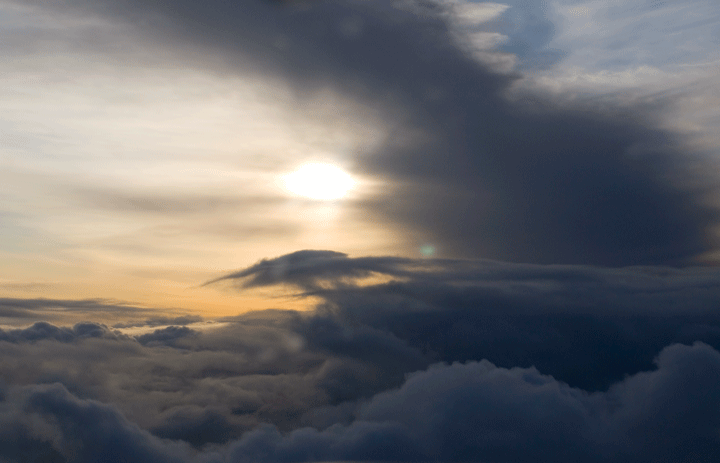
We climb out bumpily over Woodstock in the half-light of some big clouds and by Charlbury we are at 3,500ft in amongst the fluffy stuff on a Traffic Service from Brize. The clouds last intermittently until FL65 when we suddenly burst forth in to brilliant sunshine, emerging from a vertical wall of cloud in to smooth air. Hollywood would have added a sucking sound as we escaped (and probably a Mooney-shaped hole).
And now we are amongst the giants, climbing higher until they are below us. The low, afternoon sun on the clouds constantly changes as we climb West. Out with the map and we do some practise VOR tracking: yes, BCN and HON VORs and DMEs confirm that we are exactly where we think we are. Soon, these over-complex ground-bound Navaids will seem quaint: the GPS navigation juggernaut is coming, dwarfing the CAA, maybe even EASA.... EGNOS has been Live since October, even the CAA has to catch up with the reality of cockpit GPS devices soon.
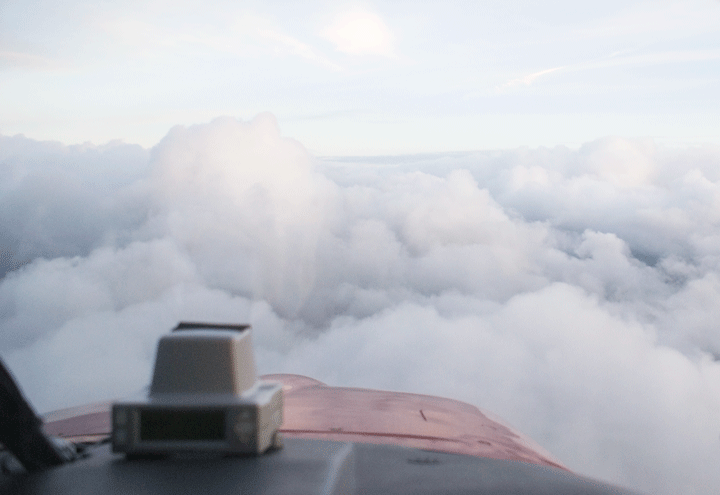 We go as far West as Shobdon, hitting FL105 in a 45Kt headwind and our nav is sufficiently spot-on that through a tiny hole in the cloud I can see, far below, and absolutely straight down, Shobdon's runway 09/27.
We go as far West as Shobdon, hitting FL105 in a 45Kt headwind and our nav is sufficiently spot-on that through a tiny hole in the cloud I can see, far below, and absolutely straight down, Shobdon's runway 09/27.
Pete smiles and puts the Mooney on a wing-tip, my side arcing straight up in to the cloudless, cold blue.
Hunched down in our seats we turn to look for some ice. The temperature has dropped to 0° but try as we might we can only get a light frosting on the leading edges, so we turn East and almost immediately the GPS descent profile tells us to start our descent.
That can't be right?
But it is: our ground speed is now 211Kts / 243mph.....
We hit the cloud over Chipping Norton and the light gets switched to "dim" very suddenly.
Emerging at 2,500ft we play the "who can spot what first" game: I get Farmoor reservoir, then Brize; Pete gets Enstone and the chimney, and we're right Base for 19.
It's Big Crab time and very bumpy down to 100 feet, then it all smooths out and we do a STOL landing, helped by a 45Kt ground speed at exactly sunset.
"So was that Medium Bumpy or Big Bumpy?" asks the Tower as we taxy in. Well, actually it felt like Small Bumpy to me.
Shoreham Dec 09
I need to go to Shoreham Airport for the day on business, so after a false start the previous day when it really was impossible to fly, the day dawns bright, warm and sunny.
I love the smells associated with aviation: the all-pervading smell of de-icer in the clubhouse; the heady aroma of methylated spirits used to clean lines off laminated maps, plogs and plates; the heavy smell of cold leaded Avgas in the tanks; the cockpit smell: leather, plastic, engine oil; the warm engine smell; new-mown grass next to the runway, a whiff of AvTur from the jets on the apron and then the exhaust fumes from the engine.
 And the sounds: the winding up of the gyros; the clunking of the flap mechanism; the click...hiss of the radios coming on-line; the heavy clunk of the starter solenoid and the low-frequency grind of the crank. Then the throaty exhaust and the small creaks of the brake release, the juggling sound of the oleos over the uneven grass and the drumming of the tyres over the taxiway expansion joints. The accelerating rumble of the tyres on the smooth runway which suddenly dies away as the wheels release their weight. And later, the chirp of them reclaiming the weight from the wings and their magical physics. And finally, the dying whine of the gyros as the Master switch goes to OFF.
And the sounds: the winding up of the gyros; the clunking of the flap mechanism; the click...hiss of the radios coming on-line; the heavy clunk of the starter solenoid and the low-frequency grind of the crank. Then the throaty exhaust and the small creaks of the brake release, the juggling sound of the oleos over the uneven grass and the drumming of the tyres over the taxiway expansion joints. The accelerating rumble of the tyres on the smooth runway which suddenly dies away as the wheels release their weight. And later, the chirp of them reclaiming the weight from the wings and their magical physics. And finally, the dying whine of the gyros as the Master switch goes to OFF.
Spend 10 minutes clearing the windows then start up the PA-28-180, taxy out and take-off in to a low sun. It's definitely a sunglasses day, and in practice I can't see much in front, so a Radar service from Farnborough is very welcome, as we VOR-track to CPT then MID dodging the Lynxes before ducking under the London TMA corner, saying goodbye and thank you to Farnborough, and hello to Shoreham.
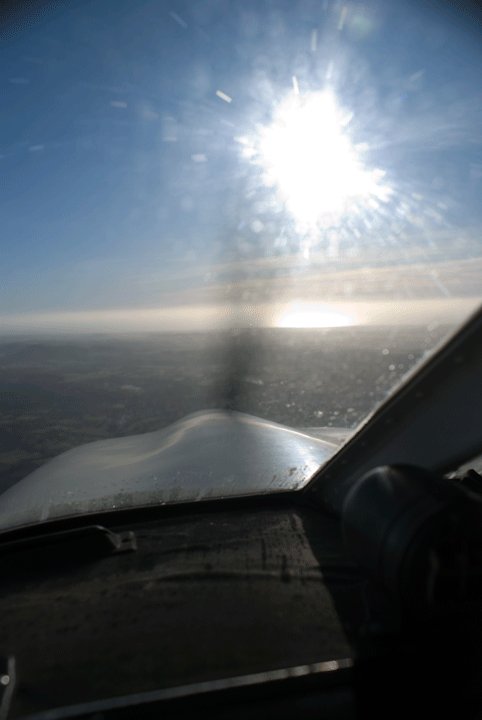 They've swapped runway ends since I called the ATIS line earlier, now it's 02LH, so a little mental reorganisation and an S-shaped descent down the beautiful green Adur valley water meadows, the water glinting in the winter sunshine.
They've swapped runway ends since I called the ATIS line earlier, now it's 02LH, so a little mental reorganisation and an S-shaped descent down the beautiful green Adur valley water meadows, the water glinting in the winter sunshine.
Turn to join Downwind, head out over the water and turn left Base according to the noise abatement plan, which leaves me much higher than I would normally be turning Final, so chop the throttle and glide with full flap to the threshold, resisting the temptation to push the nose down and force the aircraft on to the runway (thinking "I may need another go at this..."), just a quick burst of power to hop the railway line, flare over the starter extension and put the mains on the 02 numbers. Nice.
Backtrack and park outside the hangar, minding the helicopters as I turn.
The plan is to return to Oxford and land before official Night - I haven't done any night landings for a while and whilst I never found them particularly difficult I am, I must admit, rusty.
So I leave plenty of time for the return journey, but it is simply not to be.
Start up, then realise it's now rush-hour at Shoreham: can I get a word in edgeways on the Tower frequency? It takes 25 minutes to get from the hangar to the Hold point and on to the runway.
At last we climb out over the water meadows, just over a flock of birds ("we'll go there in the event of a bird strike..."), and watch the reflections of the clouds gliding along the water.
By my calculations, it will be official Night (30 minutes after sunset) just before I land.
So: I either stop at Popham and take the aircraft home tomorrow morning, or use my Night Rating in anger.
Oh well, so be it: a Night landing it is. This is within my licence provided I'm not carrying passengers, so that's OK.
As we pass Midhurst a few clouds are appearing at my level; they aren't thick but are apparently forerunners of a front. They light levels are dropping, so best to get to grips with the cabin lights now and find the torch for backup.
Farnborough are busy until suddenly all the radio traffic just stops, pretty much coincident with official sunset (the GPS goes a different colour). After a few minutes I'm convinced the radio is broken it's so quiet. I turn it up and get deafened by the next transmission. Ow!
Then, North of Basingstoke a cloud bank appears: I can go over, under or through. I'm on a Radar service from Farnborough, on the CPT VOR with ident checked and the GPS as secondary. I can see the clouds are 1,000ft thick so the bottoms are above MSA. We'll go VMC on top then drop through North of Newbury.

Now this is the first time I've done a cloud-break solo, and it will be dark in there as well, but there's a first time for everything and this is a good opportunity to expand the envelope.
It's pretty on top, the clouds are smooth with a remarkable resemblance to half-melted ice cream.
So: top of descent. Throttle back, get a 500ft/ min descent, concentrate on the AH, get a good scan working, and drop in.....
Real IMC (as opposed to "foggles" IMC) means you get to see the structure of the clouds going past you (illuminated by the landing light) and I've been worried this could be disorientiating but actually it's not, the AH stays where it is, the VOR stays centered and the VSI is steady. Just concentrate......
As we descend it gets darker, then the clouds start to thin and suddenly we are back in to clear air and it's dark. Done it. Base is 2,400ft as I thought and the Oxford ATIS had confirmed, we're still on 355° so switch from Farnborough to Oxford Approach and relax for a gentle VFR descent over Abingdon and South Oxford and a Downwind join.
Public Transport (non-pilot passenger carrying) requirements say I must have done at least one Night take-off and one Night landing to a full stop within the last 90 days, so as it's Night we'll do a touch 'n go to get the take-off then land again. I just hope I can remember how to do this....
Actually, it's a complete non-event - just like I remember it was. Concentrate on the VASIs (two red two white), drop it on, clean up, accelerate away, rotate, hold it on 75Kts, and we're back in to the circuit. Extend downwind as requested to allow a Citation to take-off, then cruise gently down the approach. It's very smooth, so flare, ease it on to the runway and roll out, taxy in and park.
Envelope duly stretched (in two separate directions), it's been a Good Day.
Not much point in having these Ratings unless you use them in anger.....
Over the snow (II) Dec 09
It's Christmas Eve and snow has blanketed the country. The weather has been too bad for flying until today, when a weather and work window opens up: Pete and I will go to Swansea.
Slip-slide over the apron to the Mooney, take the crusty cover off and stow it, and start up, before realising that I have left my headphones in the bag in the baggage compartment. Outside once more in the icy propellor-draught, grab the headphones, climb back in. Brrrrr........
We're offered a taxy to A1 for a backtrack on 19 as the Northern taxyway and runway 29 are too icy; but we then get offered 01 as an alternate as there is basically no wind whatsoever, so we take it and are off in to a smooth-as-silk morning, climbing to 2,500ft under a milky undercast.
Perform a low pass over Cornbury Park for some pics with which to torture the laid-up-with-a-bad-leg aviator occupant before climbing Westbound.
The visibility is extremely good once we are clear of the ground mist, which persists and thickens as we head West, power pylons and hill tops sticking up through it, until we reach Birdlip and the cloud spills over the edge.
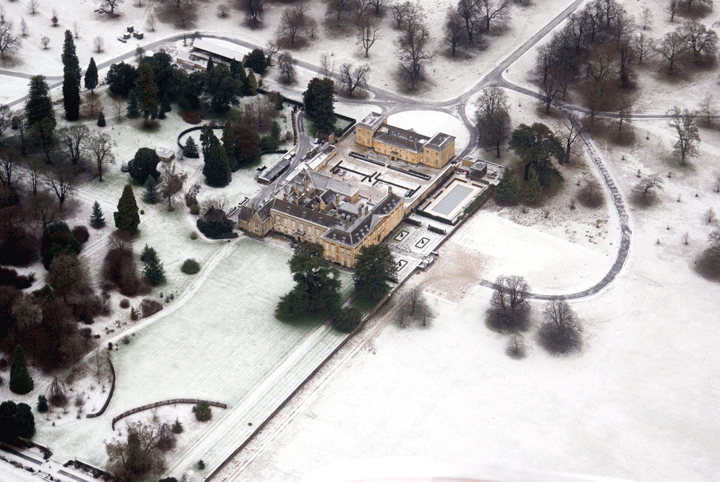 Otto Otto
|
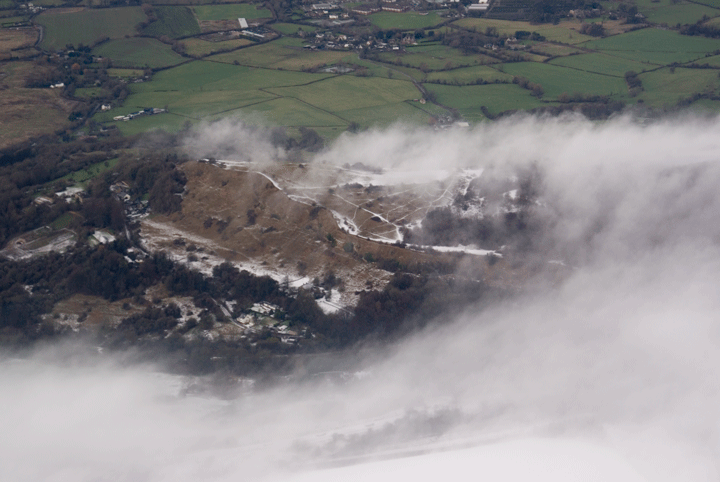
|

|
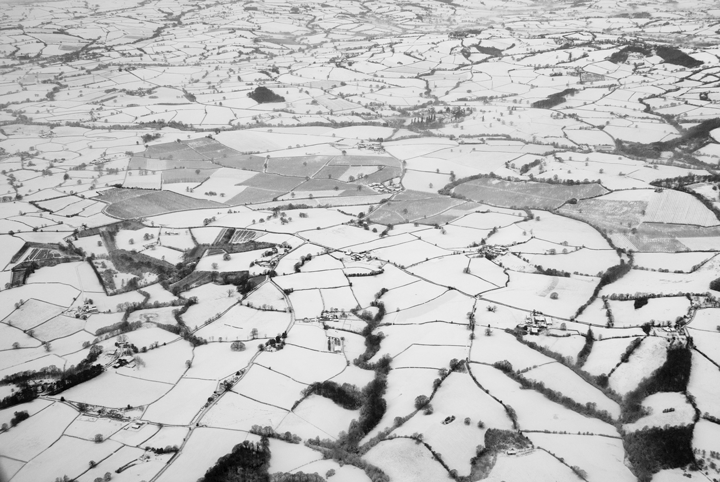
|
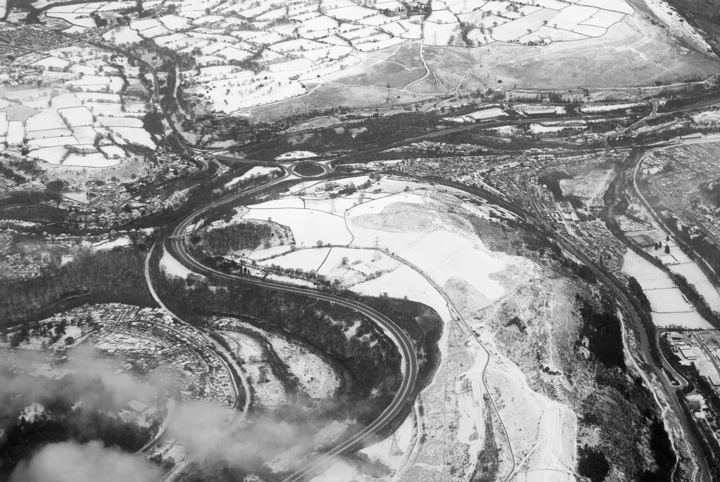

|

|
But the Severn valley is clear and green. The visibility is superb, and before long we are back over the snow tracking over the Wye Valley and up towards the Brecon Beacons (it's always amused me that righto n the top of the Beacons lies the Brecon (BCN) VOR, a radio beacon on the Beacons....).
The mist is lingering in the valleys but the hilltops are clear, and we dodge the big bits of cloud hanging over the really big hills before turning South West in the now-bright sunlight for Swansea.
For some reason runway 22 is incredibly easy to spot from 20-odd miles out so we perform a long, straight-in approach and Pete plops us neatly on. It's warmer here, but the café is closed so instead we bribe our way in to the warm tower with mince pies and chat with the friendly staff.
As we climb back out we know a direct track will take us through the Northern section of the Cardiff CTZ: we could divert North but as Cardiff are quiet we ask for and get a Zone Transit. Bizarrely, this is at 5,000ft on their QNH as opposed to a Flight Level; more normal at this altitude.
Cardiff ask us why we wish to remain so low, which is of course because we wish to remain under the airway.
"It's my airway, and you can use it" is their quick riposte, and as an afterthought "Can you accept an IFR routing?". Now the strict answer to that is "No", as in order to accept we'd need to have a JAA IR, but as we are happily VFR, the air is smooth and we have 2 IMCs (which sort-of make an IR...) we accept, climb another 1,500ft and maintain height and heading. My first Airway. At 6,000ft we can see a very long way indeed: from Cornwall away over the right wing to Birmingham in front of the left wing.
Cardiff hand us to Bristol who ask if we are expecting a VFR recovery at Oxford: we are quite happy to perform an IFR recovery, but why make life hard? Descending over the mist, it disintegrates as we pass over Charlbury and we trade landmarks before joing Right Base for 19 and home.
What a great way to end the year.
PA32 Revalidation Apr 10
We build a house.
By which I mean we have the shell of a house built, then we start to complete it.
Which is a lot of work.
And costs a lot of money.
Including my flying money......
So for for four long months I don't fly: I just work and build things at the weekend. I even buy a concrete mixer....
But suddenly and unexpectedly I badly need to fly for a specific purpose. And I need to fly a Cherokee Six.
Some rust removal is required, so I'm booked to fly on a bright but hazy April afternoon. After 4 months it will be interesting to see what has decayed in my flying skills.
I need to do a checkout with the newly-qualified Wayne, so spend an evening with head in books ensuring I have all the in-flight checks mentally stashed away again, a few emergency drills mentally practised and the differences between the PA-32 and the PA-28 carefully noted and written down (mainly speeds, and Kts being on the inside of the speed dial).
Out to the aircraft, and I am struck once more by that special “GA” smell; the mixture of hot interior plastics, aviation fuel, lubricants and exhaust gases. Run through the pre-flight checks carefully, and familiarise myself once more with all the kit.
Wayne gives me a good 10 minutes to just sit and fiddle before he comes out, which is hugely appreciated as I hate being rushed in this area.
We talk through the checkout, fire up and take-off, nose-high to maintain 81Kts best climb, do a noise-abatement power and prop reduction at 1,000ft to 23½/23½ and climb out towards Banbury.
HASELL checks complete, we do steep turns (why? What purpose do steep turns have in a check-out, apart from being fun of course?). I can hold height and speed, and with the VP prop I don’t even need extra power, so we go round and round in increasingly steep turns for a while. It’s getting marginally aerobatic by the time Wayne gets bored, and we do stalls, which I was expecting and are predictable.
A PFL (we choose different fields, but mine has more houses nearby and we’d have dropped it in nicely), then we return for some circuits. We’re the wrong side of the runway for the requested overhead join, so I join crosswind instead (resulting in grumbles from the right seat, but I’d only have had to go past the airfield and turn back), and turn downwind for some circuits.
I’d forgotten just how hard the beast is to slow down and get stable in the circuit: I aim for 100Kts with one stage of flap, but keep getting too high or too slow, too high or too low. I feel like a beginner again....
Turn Base, get the 2nd stage of flap out, slow it right down to 80Kts and perform a creditable approach followed by a firm landing. Hmmm, let’s have another go. This time it’s more controlled on the downwind leg, better checks, better approach and a better landing. The third time is actually quite good, and we roll in happily. I feel greatly rust-free and polished.
PA28 Revalidation 31 May 10
I need to go flying on Wednesday for work (Oh, what Glee to be able to say that!) so need some circuits to get my eye in for that last pesky 100ft.
I haven't flown this particular PA28 for more than a year and have an especial soft spot for it as it was the aircraft I first soloed in; it's been recently repainted and looks very smart.
There is always a perceived pressure to get a move on when carrying passengers or an Instructor, but today I am on my own and it's nice to do all the pre-flight checks unhurried and get it really right.
The wind is right down the runway so we should be able to concentrate on spot-landing. The first take-off goes well and if there's one thing I've found condusive to unharrassed pilotage it's Trim... Trim... Trim... so lots of trimming and the feeling you are fighting the aircraft never happens.
Mind Danger Area 129, be mindful of Pete's mantra concerning bank angle in a climbing turn, so keep it to 15° and soon we're settled at 1,500ft and 90Kts.
Radio call, BUMMPFFTCHH checks and we settle in to the landing configuration: 2 stages of flap, 75Kts trimmed and stable. That way any gusts, speed or height excursions can be quickly dealt with from a stable path.
Cruise down the approach cone and land long with a little too much back pressure and ground shyness, clean up and take off again.
This time around it's better: much better. Where I'm going always feels short, so spot-landing is important here and this time we're flaring over the threshold and hitting the numbers. Better.
The third time is perfection, so we'll do one more.
And of course the last one is a bit of a banger, but on the centreline and in the right place. Keep the speed up as there is another aircraft behind who wants to land, brake a bit too late and end up finding the surprisingly low cornering limits of a PA28. If pushed, I now know they squeal and tend to understeer and head for the grass. OK, we didn't go on the grass, but next time I think a little slower...
Taxy in satisfied, I now feel back in the landing groove.
Shoreham and Bembridge 2 Jun 10
We need to take 3 people and luggage to the Isle of Wight.
I have a spreadsheet that takes the donkey work out of the weight 'n balance calcs, and it tells me we are going to be within limits but the CG will be a long way aft. I wonder what effect it will have?
We arrive and it's very hazy. It's forecast to clear by 9am... then 10am... By 10.00 it's good enough to fly but with some scattered cloud on climb-out to fly through. I have an IMC, this will not be a problem. But it is a problem with the owner of the aircraft who makes us wait a further hour until the sky is virtually clear. Now, where were those "Aircraft for Sale" classifieds?
We load up with the luggage, as planned, in the rear luggage area, start up and depart. It's not until we reach 55Kts and the aircraft flies itself off I realise the effect the aft CG is having. The aircraft just won't fly properly at this speed and mushes as we drift left off the runway.
Time for action: gentle forward motion of the yoke and we trade height for speed.
We can, if necessary, skip along the grass, but it doesn't come to that and as we re-enter ground effect everything stabilises, the aerofoil reaches full flying speed and we accelerate and start to climb. Still, it felt awful....
Mental note in future that with aft CG we need to keep the yoke forward and not unstick until 65Kts (unless we have 1 stage of flap of course: I know this aircraft will fly at 55Kts with flap).
Climb out, right turn to the South and change to Approach. There are some clouds so we whisk through them (good IMC practise), then around Newbury we change to Farnborough, carefully trim straight and level and give Frank the controls.
It's interesting watching him over-control the aircraft: now I understand Pilot-Induced Oscillation. There are no thermals and yet he porpoises and struggles to keep the aircraft level. After a while Lucy and I feel a bit queasy. At one point I take it back and just don't touch the yoke; it calms right down and the ride is smooth. I know I was like this not that long ago, so I have a lot of sympathy...
As we near Portsmouth and the sea comes in to sight (it's a bit hazy) we switch over from Farnborough Radar to Bembridge Radio, and the contrast is extreme: from clipped Civil Service efficiency to chatty GA-speak: "Ooh, is that you up in the Tower, Jim? I'll come up when I've landed and we'll have a cup of tea".
Love it.
We descend over The Solent (leaving plenty of height; we're not wearing lifejackets today) and look for Bembridge. Damned if I can see it. Lucy points it out much further East than where I was looking - typical....
Join Downwind LH for 12, watch the aft CG on the approach and grease it on a bit farther down the runway than I would have preferred as it is downhill, but nicely controlled. Roll out with gentle braking and taxy in to parking.
After a day's work we return to the aircraft, which is hot and airless. Open all the windows and doors and let it cool off while we Transit-check, then fire up. We have a lot less stuff to take back, so the CG will be further forward.
As we power-check, Bembridge clears us on to the runway, then tells us they are all off home for the night! Ah well, blind calls it is then.
Backtrack 12 then take off downhill. Hold the aircraft on the ground to 65Kts and then rotate firmly and we climb out over the trees and park homes before clearing the ridge and turning right to go around the island for some photos.
I love these gentle climbing turns over water where it's smooth. It appeals to the part of me that desires cleanness and smooth curves in 3D; I don't know why. Perhaps I'm just sad.
At 1,000ft we level off and cruise around the coastline keeping an eye out for opposing traffic. You're meant to keep to the right of a line feature, but doing that would ruin the views, so we keep a good look out and get a squawk from Solent Radar who are very helpful in between directing RyanAir traffic. We circle over the Needles and head East over the cruise ships and sailing craft, then turn North over POMPI from where I let Frank fly us North.
Again, he can't keep the wings level and this mystifies me until I realise there is no defined horizon this evening. I used to struggle with this as well as keeping the nose at a strictly defined point on the windscreen, which doesn't work for me because it depends too much on the loading of the aircraft, where I've got the seat, how much power is on and whether there are any thermals. So don't let anyone tell you that's the way to fly level: instead use the variometer and altimeter.

Despite the porpoising (which improves once Frank knows about the AH) it's nice to have a flying pilot in the right hand seat and to become systems manager: FREDA checks, pre-loaded radio frequencies, Oxford ATIS check, good look-out (hazy, so Landing Light goes ON), check GPS against VOR, map and visual cues. All is well with the world.
Report re-joining, cruise descent (Carb heat ON, there is moisture in the air), request Right Base Join for 01, divert a mile to the right to avoid a balloon over Port Meadow, report Right Base and cruise down the approach to a gentle flare at 65Kts, a kiss of the tyres, and a bounce...
Huh, what was that?
We go up about 2 feet then drop gently back down again and stay down. But it was just so entirely unexpected. My immediate thought is that we are still doing 80Kts or so but no, the speed is now 40Kts and reducing. I still don't know what caused the bounce, though. There is very little wind and we may have caught a little gust, but it's 7pm and there are few gusts about. I check the undercarriage after shutdown, but whatever oleo peculiarities may have been responsible are not visible. Odd.
Circuits 30 Jul 10
I need to go out this weekend and have been very busy with work, so have not flown for 7 weeks. PFT are happy for me to go, but I would be happier with a few preparatory circuits.
And to think I used to hate circuits; I just wanted to get out and fly.... Note to all aspiring PPLs: you can never do too many circuits, even after you achieve your license.
So out to the aircraft, and slow, unhurried checks by the book while the smell of vinyl and Avgas soaks in to the nostrils. Start up and taxy out, and I can see the rain a-coming across the fields to the West. It will only be a shower, but it could make things interesting. The windsock flaps as the associated winds get up.
The PA-31 in front requests a backtrack and I am asked if I can accept an immediate take-off ahead of him - you betcha! Cleared for take-off, wind up the engine and we're rolling before the end of the acknowledgement.
The PA28-140 climbs well one-up but the first circuit feels rushed, and I feel not entirely in control, ballooning above 1500ft and not keeping the speed at 90Kts. It's gusty and I am worried about the landing. The approach is high and messy, with big crab and gusts, but we cross the threshold on speed and on height, flare, concentrate on flying it down the runway at 2 feet above the centreline and we settle gently on. OK so far...
Clean up, accelerate back down the runway and rotate. At 1,000ft we hit rain and the airfield disappears: Ooh, this is fun.... Much more in control now, correct speed, height and trim: lots of trim. We're IMC now and on the runway heading; out of the rain shower and right on target, turn Base and drop down for a much better-controlled arrival, a real no-feel touchdown and accelerate away. It's coming back.
After a few more the wind dies down as well so we can concentrate on that last few feet, getting as small a descent rate as possible as the speed bleeds off for a softer touchdown. Better.
After a few I decide to land off the next one and hey presto, a PA-31 is on the end of the runway. I have clearance for a land after but he's just not rolling and it looks dodgy (always P1's decision, no matter what the Tower says) so we go around and get an early turn over the hangars for another approach. And of course this time a Diamond from Enstone cuts in right Base and again it looks dodgy at decision time but he is going quite fast so we land after, and it's nice and smooth.
OK, I think I'm happy.
Taxy in and shut down, listening to the descending whine of the gyros and the ticking of the cooling engine. I just love doing this...
Shoreham and Bembridge 31 Jul 10
We are planning to go to Shoreham for a lunch party in Worthing. Nessie has cooked a strawberry Pavlova for the party and I am under strict instructions to fly smoothly lest the Pavlova be disturbed.
The aircraft is booked but the weather is not behaving: we wake up to drizzle and low cloud. However, it is forecast to clear and by 9.30am it does, but when we call Shoreham they tell us they are 400ft in drizzle.
We have a choice: scrub and spend 3 hours driving down or take-off and see how far we get (diversions could be Popham, Bembridge or Goodwood). If the cloudbase drops we may be able to squeeze through to the coast under the clouds or go on top and drop down over the sea near Shoreham for a low-level run in to 02 (we already know they are using either runway as there is very little wind).
Everyone else is planning to go to Jersey, but we arrive to be told that they have scrubbed that as the weather is apparently awful. We all know it will clear through: why not try it; you can always turn round or divert, surely? Compton Abbas would be an appropriate diversion, I'd say; they do a good lunch.
Anyway they don't, and all head North, but as we clear Oxford's Approach frequency for Farnborough we can hear them coming back, compaining of low visibility over Nottingham. It sounds like we may have more fun than any of them....
The cloudbase, at 2,500ft over Oxford, slowly descends to 2,000 and then 1,500ft as we cruise South. This is a great opportunity to practise VOR tracking so we track inbound to CPT, then outbound from CPT to MID. It's interesting the disparity in tracking on the 2 VORs: even though they are set the same one is always one bar out, so there is obviously some instrument error somewhere. Nice to have the confidence of a VOR track and a DME, with the GPS as a useful back-up. But you do lose situational awareness very quickly: is that Basingstoke or Reading down there?
By the time we approach Shoreham the cloudbase is down to 1,000ft and we're intermittently IMC, but that's enough for a circuit so we hail them and they are amazed to hear from us: we appear to be the only ones flying today...
A 900ft QFE (well, no one will know) circuit for 20LH with our fin in the clouds, turn Base over the hills and this is the approach where you feel like you're going to hit the hills, then suddenly you're too high as the ground slopes away beneath you. Speed control, it's all about speed control. Nail it and trim it at exactly 75Kts, flare over the threshold and stop worrying about running out of runway. And we're down, really gently, on the c/line and rolling smoothly with oodles of tarmac left. Vacate the Active and park on the grass outside the Eastern Atlantic hangar, as requested. Shut down, and the silence is deafening. No one else is about.
Wow. And the Pavlova is in one piece, too.
Since I last saw him a couple of years ago my Godson has gained his Rotary PPL. Not bad at 17 years old; he learned on a jet helicopter, and was taught by Dennis Kenyon who is the ex-World helicopter Aerobatic champion, so he should know what he's doing.
 He also has his driving Licence and has been asked to pick us up from the hangar. Nessie and I are a little worried about being driven by a 17 year old, but even more worried when he offers to take us for a spin in the MD600.
He also has his driving Licence and has been asked to pick us up from the hangar. Nessie and I are a little worried about being driven by a 17 year old, but even more worried when he offers to take us for a spin in the MD600.
This is a serious helicopter: it's been flown around the world twice and is the rotary equivalent to a Cirrus SR22 or a Bentley. Will we be OK?
So we strap ourselves in (it feels weird to be a passenger in the left seat...) and he fires up the jet. We're parked facing the hangar, with an Agusta A109 on our right and a wall on our left. So he just lifts a few feet and hovers backwards out of the slot. Can't do that in a PA28... Then he slews it round like a hovercraft coming off the ramp at Dover and we're over the grass at 50Kts and 25ft. I don't like this nose-down attitude at such a low altitude but this is a helicopter, and a damned powerful one at that. And he is controlling it beautifully. We lift over Lancing College and head in to the hills, skimming smoothly over the green fields and numerous quarries in the local area. Quite makes me want to take up rotary, this freedom to loiter and land anywhere.
But the cost...... about 3x anything fixed-wing, as a rule of thumb. Eeek.
He's very good, though: smooth, controlled and obviously a natural pilot. I'm seriously impressed and not a little jealous.
After half an hour we come back to earth and he pops it neatly outside the hangar, without blowing either our PA28, the other helicopter or the next-door hangar's Bulldog away, which is no mean feat.
Drama-free and very professional; he will Go Far, I am sure.
Early this morning we had a plaintive call from a client asking us to fix his wayward ADSL router on the Isle of Wight. Because this is a business router its configuration is a little more complex than the average so we really need to do it on-site; the easiest way being to turn left on leaving Shoreham.
Shoreham have changed to the grass runway and we rattle and shake on the dry earth before climbing out smoothly in to the late afternoon sunshine and following the coast towards Bembridge.
The sun is in our eyes and finding the runway in the haze is hard. I don't like relying entirely on the GPS for navigation but in this case it's the only way to ensure we are on the right track for a straight-in for 30. A quick text to our client to tell him we're coming, and we cruise-descend to 1,000ft at which point the runway appears out of the murk. Call Long Final, BUMMPFFTCH and cruise down the approach... at which point it starts to get interesting.
We have green grass which is radiating heat, dark trees absorbing heat, and campers with barbecues. Up, down, sideways we go, a real rollercoaster.
Speed control, Speed control, Master Luke. That's the key. Use the forks.
Flare over the threshold at 70Kts and a very smooth arrival; ooh these are getting better. Backtrack and taxy in. It's a lovely afternoon.
IT repairs accomplished, we walk back to the airfield: it's 8.00pm on a beautiful sunny summer's evening. Bembridge is deserted and there is a strong Westerly wind. So 30 it is, then.
Transit check, fire up and taxy out. Power checks, then blind calls and backtrack 30. Turn round, and roll. We're off by half way down the runway and climbing out over the variegated green fields. Bembridge harbour looks beautiful in the low summer evening light as we climb out towards Havant and turn North.
Farnborough have gone home, so we maintain a listening watch on their frequency. It gets a little hazy, so landing Light to ON. Mental note: next time turn the strobes on as well. VOR tracking again, and for some reason whilst the VOR tracks true the GPS tells us we are off-course. The VOR is right, so we track that, but it niggles until finally I realise I have set the route on the GPS wrong. Ha.
There are a lot of gliders about, even at 3,000ft, so we keep a very good watch out as we cruise North.
We took off with a strong Westerly wind, but up here I spend some time trying to work out why we need to steer 005° to track the 345° radial: even allowing for magnetic variation that's an offset in the wrong direction with a Westerly wind. Well of course who says the wind direction at 3,000ft is the same as the wind direction at ground level? We have an Easterly wind up here. Interesting.
Switch to Oxford Approach at CPT and listen to a EuroCopter pilot chatting up the very nice Tower lady. When he's finally finished we can ask her for a Downwind join for 19 and we cruise descend to circuit height. She even turns the PAPIs on for us, which is a distraction, but the wind has dropped and I concentrate on stretching those last couple of feet... and am rewarded with a satisfyingly smooth arrival. We roll out and vacate left, park up and shut down. What a lovely day.
And that brings me to a total of 100.4 hours Pilot in Command (P1) and maybe a moment for reflection: what have I learned in that 100 hours in the left seat?
- P1 means "The Buck Stops here": you are responsible not only for your own safety but that of your passengers, people in other aircraft and people on the ground. Easy to say, sometimes not quite so easy in practice.
- England is so very beautiful from the air: different every hour of each day, different from every height, different from county to county. Unlike the US which is homegeneous for such large areas, Britain changes every few minutes, both in scenery and in radio accents.
- Circuits are your friend. Never pass up an opportunity to do a few.
- Never let anyone harass you in to hurrying flight preparations or going somewhere physically you haven't already been mentally
- Every flight is different, and you can't relax until you have exited the aircraft
- If I don't fly for a while it's the last 3 feet of the landing that suffers
- Flying an aircraft is the most incredible privilege we have; in many countries of the world private aviation is simply banned. You can imagine the military Junta in Burma discussing it: "....and you say we should allow our citizens to just fly aircraft freely around the country? Don't make me laugh...". A country's attitude towards private aviation is an excellent barometer of the freedom it affords its citizens.
Kemble and Caernarfon 8 Aug 10
Thinking a little bigger now: let's plan to go to Kemble, pick up Mother-in-law plus dogs and take them to Caernarfon, have a picnic on that beautiful beach and then drop them back at Kemble.
A fair bit of organisation and a lot of flight-planning is required, plus a plane for the day.
Sunday dawns hazy and not too hot, but the forecast is good and by 9.45 we are packed in to a PA28-180 at Oxford and ready to go. Fill up with petrol, taxy out for 01 and depart.
Kemble have a steam fair on and have told us it will be very busy with arriving traffic, so we are expecting a wait on arrival.
Left turn out and climb towards Charlbury; straight to Brize and request a Zone Transit for Kemble. Granted a Transit at 3,000ft we are asked to remain VMC which is, of course, impossible as there are scattered clouds above 2,500ft. Stretching the point we cruise on, in and out of the clouds, but actually we are more IMC than VMC so it's a bit naughty and we ask for a descent to 2,500ft which is duly granted.
Within 20 minutes we are clear of the zone and swap straight to Kemble who clear us for a crosswind join: it turns out we are the only aircraft on frequency and soon we are downwind then Final for 26. This is a very big runway and we use lots of it making a nice gentle arrival before vacating right and parking next to the AV8 cafe, still the best taxy instructions you'll get anywhere.
Kemble is how an airfield should be: busy, varied, friendly, not too up it's own arse (Oxford take note), with a café that non-aviators actually go to and can drive in to, not always to watch the aircraft.
And non-aviation exhibitions: today the entire South side of the airfield is covered with traction engines and other steam paraphernalia (that for some reason include a Rockwell T28 Trojan).

And yet business jets and 747s use this airfield; many of the airliners, however, like a roachmotel, check in but don't check out. Scrap candidates today include several ex-KLM and Southwest Airlines 737s in various stages of disrepair. Seems a bit sad, though.
All coffee'd up now with added Mother-in-law and her two dogs we taxy out and after an entirely unnecessary wait at the far (Far, Far Away) end of the runway for a business jet to backtrack, get his IFR clearance, rip a couple of CDs for the in-flight entertainment, file his nails etc while we get hotter and hotter, we are finally cleared to depart in his wake turbulence. Typical.... Next time we'll demand a midpoint entry.
Aston Down is busy with gliders, so we remain South of them then curve round to the North West, straight to London Information West who are fabulously efficient and very busy. The weather is worse here, with increasing cloud as we cross the River Severn and in to Wales.
My Garmin GPS has begun playing up: when it gets hot it fails to pick up satellites on start-up. It has been sitting in a hot aircraft and now refuses point-blank to recognise the existence of any satellites at all, so it's back to old-fashioned VFR nav with some VOR assistance. Map on lap we follow the line across Wales and, considering the length of time that has elapsed since I've done this in anger, we do pretty well. There are, however, two small 10,000ft Danger Zones in Wales and we are planning to fly between them so just to be sure I fire up Memory Map on the iPhone and double-check our location. Yup, perfect. Nice to know for sure, though.
The countryside becomes wilder as we head further West, heather and wind farms replacing arable and sheep, until we crest the final hill and see the sea and Aberystwyth ahead, cruise descending to 1,000ft for a run up the coast. The weather is better here, suddenly: the sun is out and it's warm.
After a battery-out rest and a reboot the Garmin decides there really are satellites out there after all, but this is something that needs fixing.
A swoop inland then back West to view Portmeirion then we climb over the saddle and past the TV mast, bid goodbye to the super-efficient London Info and hello to the relaxed lilt of Caernarfon; join crosswind for 26 RH at 1,000ft and drop smoothly over the caravans for a gentle, controlled arrival. Backtrack and park up, unpack the picnic and off we go.
 After our picnic on the beach we take-off again and climb over Caernarfon to see the castle before heading up a random valley in to Snowdonia.
After our picnic on the beach we take-off again and climb over Caernarfon to see the castle before heading up a random valley in to Snowdonia.
We just need to ensure the terrain doesn't out-climb the aircraft and we'll be fine; not too close to the ridge tops as a bit of rotor lurks there; we can feel it about half a mile downwind of the ridges bumping us about.
We top out at 2,500ft and fly out over Portmeirion and South again down the coast. Passengers snooze and I have an opportunity to watch the scenery and try, unusccesfully, to get London Information's attention. They are extremely busy and after several attempts I give up and simply monitor the frequency. If I have a problem someone will hear me even if they don't.
Turn inland again around Aberystwyth and over the wind farms, back between the two Danger Zones and over Ross-on-Wye the GPS tells us we are 10 minutes from Kemble. That can't be right, surely? But yes, it's only 10 minutes at 120Kts from Wales to the Western edge of the Brize Zone. Scary.

Downwind join for 26, mind the villages on the turn to Final and make a great approach followed by a lousy landing, my first bad one for ages.
Get it low and slow, with a high descent rate and I'm too low to cushion it fully.
Not really a hard landing, but we're aiming for cushion-soft arrivals every time now.
Thumpers are for low hours pilots; it's humbling to know I can still do them.
Taxy in, book in, eject Mother-in-Law and dogs and immediately taxy out. I've never done such a quick turnround.
Within 10 minutes we are taking-off again and turning North East for Oxford. As the GPS is playing up again we'll VFR Nav it round the North of the Brize Zone.
We change to Brize and the Controller is the tersest, fastest talker I have ever heard. I have been warned about him and have my pen ready for squawk, local QNH and instructions. He's not unfriendly, just very clipped and super-efficient, even offering us a Transit, although I'm committed now to a zone-free return, so "Negative Transit, but thanks". Within 10 minutes we swap to Oxford and request a right base join for 19, cruise-descend and roll right for Final, and this time the landing is perfect, virtually a no-feel arrival, on the centreline, a tiny squawk from the stall-warner and we're rolling. Well, you're only as good as your last landing....
Cardiff Night ILS Aug 10
Tonight Pete and I are going to Cardiff in the Mooney to practise night ILSs and night navigation. It's a virtually cloudless night with a full moon, so we are cheating a bit, but the view is amazing. Once airborne from Oxford we climb to 5,000ft and the earth wheels past; bundles of light denoting conurbations and dark patches that could be fields, or water, or doorways to another dimension.
Swap to Cardiff Radar who vector us South then West on to the Localiser for 30. They keep us at 4,000ft until very late, and we have to do an ear-popping initial descent until our VNAV profile stabilises and we trundle smoothly down the ILS. Pete's ILS approaches are much more controlled than mine, but then he has done many more.
I am always interested to see how close the runway lights are at Decision Height, and at 528 feet they are pretty damned close. If you really can't see the lights at this height it must be foggy at ground level.
We taxy over to the GA centre, which at this time of night is closed and dark, but perfect for answering the call of nature, whereupon we start back up and taxy out for departure.
Cardiff gives us a Special VFR departure "via Wendover mast". Huh? It takes Pete and I 5 minutes to find the Wenvoe TV mast on the map, and all the time we could see it out of the window....
We use up a tiny proportion of their tarmac and turn North East, climbing to 4,000ft and then 5,000ft.
The world looks so clean from up here at night. There isn't much traffic, and the roads look clean and neat. Mist is just starting to fill a few valleys: we start discussing mist-caused diversions if Oxford is below Minima. We decide that Gloucester would work, or Brize Norton in a pinch.
We run in to IMC and the wingtip strobes freeze the propellor blades against the cloud. Never seen that before: interesting effect. Back out in to VFR and we can see from Wales to Birmingham, the night is so clear. It is very smooth as well; this is why we fly at night.
Pete has a nifty trick with his GPS that puts the beacon track for the Hold on the GPS map, allowing excellent situational awareness and we take up the hold, trundle gently around a four minute racetrack and pass overhead the beacon for a nice cut. Pete is relaxed about his descent and has all his checks done before starting to turn for the Localiser. We blow straight through the beam, which would have me panicking but Pete just carries on turning, gets a 30° cut and the needles come back in by 5d. Nice recovery. He knows what his descent rate should be and has it trimmed out so the VOR needles barely move as we float down the approach, mist patches now in many of the valley bottoms. Decision Height is, once more, amazingly close, and we plop gently on to 19 and roll home for a well-deserved pint.
Now I just need to do that from the left seat. But things are a-moving on that front, I may soon be able to escape the wearing constant revalidations and flight school rules.